OHIO today
FALL 2025
Game Time
Student experiences lead to big careers in sports broadcasting
Forged in Fire OHIO’s highly ranked ceramics MFA burns bright
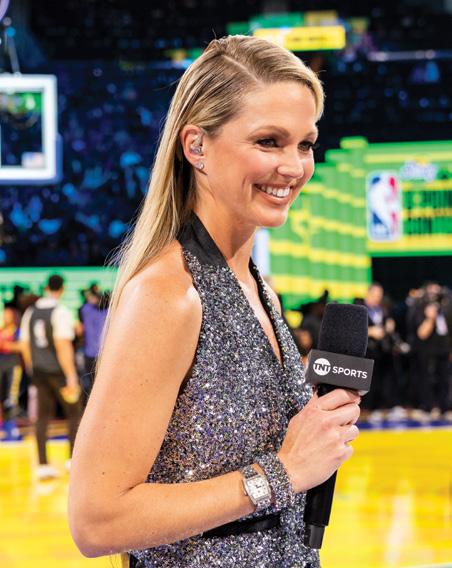
PRESIDENT’S MESSAGE

Student experiences lead to big careers in sports broadcasting
Forged in Fire OHIO’s highly ranked ceramics MFA burns bright

PRESIDENT’S MESSAGE
Greetings, Bobcats!
At Ohio University, we believe learning doesn’t stop at the classroom door—it expands into communities, clinical settings, creative spaces and professional environments across the state and beyond. Experiential learning is a defining part of the OHIO experience, and in this issue of OHIO Today Magazine, you’ll see just a few examples that bring that commitment to life.
You’ll read about ceramics students preserving and advancing a rich tradition in our iconic kiln yard, Scripps students delivering real-time sports coverage
alongside professionals, and nursing students stepping into the heart of our region’s rural health care system. These stories only scratch the surface of the powerful, hands-on experiences shaping our students’ education every day.
This work is deeply connected to our mission: to advance knowledge through a combination of teaching, research and service. Our Dynamic Strategy reaffirms this commitment, placing experiential learning at the center of our efforts to prepare students for meaningful careers and lifelong leadership.
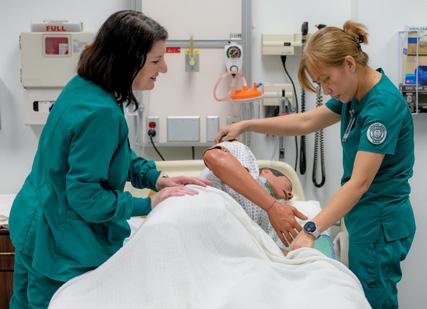

FROM PRESIDENT LORI STEWART GONZALEZ
A new chapter in arts education is underway with the April groundbreaking for the Violet L. Patton Center for Arts Education, a cutting-edge facility that will house programs and collaborative space (left). The event marks a pivotal moment in the Chaddock + Morrow College of Fine Arts’ renewal strategy, which aims to foster interdisciplinary collaboration by creating innovative, modern spaces for artistic growth.
Through programs like OHIO Guarantee+, we are helping every student build a personalized plan for career readiness, supported by faculty mentors and engaged partners.
And that’s where you—our alumni—play an essential role. As a global network of Bobcats, you have the opportunity to share your experience, offer mentorship, provide internships and open doors for our students. Whether you’re in health care, business, the arts or public service, your support helps shape the next generation of thinkers, creators and doers.
As you read through this issue, I hope you’re reminded of the hands-on, hearts-open education that makes OHIO distinctive—and I invite you to be part of our continued impact.
Warmly,
Lori Stewart Gonzalez President

The latest Carnegie Classifications designated OHIO as one of just 21 R1 “Opportunity Colleges and Universities” in the country and one of 40 “ProfessionsFocused” institutions nationwide, affirming OHIO’s national leadership in delivering an accessible, high-value education dedicated to career readiness. These recognitions affirm the University’s mission to blend academic excellence with hands-on learning, preparing students to make an immediate impact in their fields.
In a transformational show of support for health care education, the Osteopathic Heritage Foundation has awarded OHIO $25 million to fund scholarships for students pursuing primary care careers in high-need areas. The funding is part of the Foundation’s recent $70 million gift to Heritage College of Osteopathic Medicine, one of the largest in OHIO history.
Also this spring, the University recognized historian and author Kevin Mattson with its highest faculty honor: the Distinguished Professor Award. His decades of influential scholarship and unwavering commitment to students exemplify the excellence that defines OHIO educators.

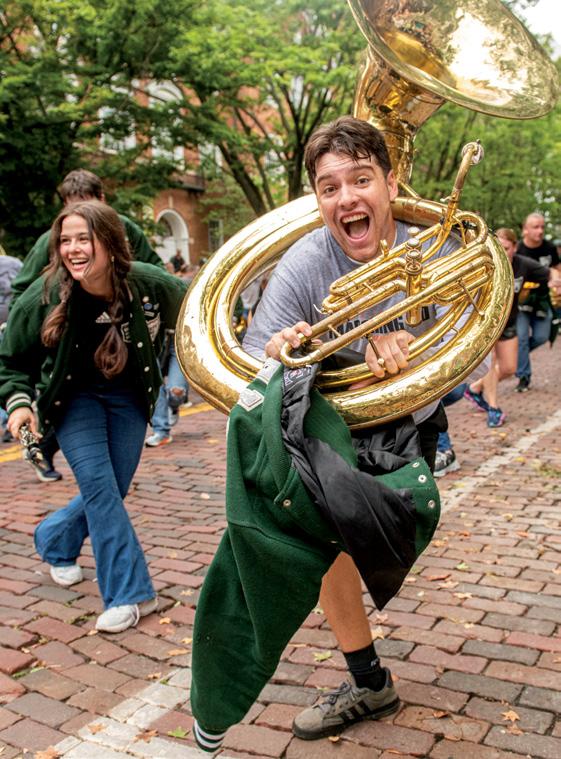
ON THE COVER
Allie LaForce, BSJ ’11, got her career started through experiential learning at OHIO. Learn how sports broadcasting opportunities set a foundation for her and others on page 26.
PHOTO BY JOHN NOWAK/TNT SPORTS
[THIS PAGE] The Marching 110 Alumni Band hit the bricks at Homecoming 2024. PHOTO BY ELI BURRIS, BSJ ’16
Recollections of The Ridges
Thanks for all your great work spotlighting the ephemera of the OHIO community! My family made great memories while I was a student, including hiking often at The Ridges. My mom, Sandy Myers, recently completed her painting of an enchanted Ridges at Halloween. The eerie architecture and ghosts in the painting evoke the mythology The Ridges are known for, while its critters and pumpkins give the artwork a humorous feel. The piece is a salute to haunted Appalachia, the good spirits legendary to its valleys, and the lifelong zest for creativity that Athens energizes in all who experience it.
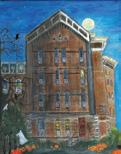
Fun fact: Mom was born Oct. 25, 1957—only five days after President Lori Stewart Gonzalez! We sent her a copy of the painting and shared how close their birthdays are. —Christopher Myers, BA ’12
Your story on WOUB’s 75-year journey (“Making (Air)waves,” spring 2025) sparked some memories. The station was only nine years old when it was the subject of a two-page picture spread in the 1958 Athena yearbook. I was a photojournalism major and the Athena photo editor, so I assigned myself to shoot this juicy story to spice up the advertising section. (We wanted to entice readers to thumb through that supportive section of the yearbook that’s often overlooked by readers.)
The WOUB broadcasting equipment in 1958 was probably not digital, and “TV” was not
much more than a couple of capital consonants. But the attitude of the students in 1958 was just as professional and intense as it is today. Technology may have advanced, but OHIO students’ ardor and dedication to professionalism was evident back then, too. —John Alter, BFA ’58
I was a professional staff member at WOUB-TV during a most interesting era: mid-to-late 1960s. Our slogan was similar then: “A professionally staffed, studentoperated broadcast station.” I was a communications specialist who also did several live-oncamera gigs to intro entertainment programming from NET (National Educational Television). We were
thorough and tough pathfinders; PBS was in the future.
I thought someone may be eager to research coverage of one of the two most prominent news stories of that era: The Silver Bridge Disaster in West Virginia. I don’t recall the details, but our coverage of the event on film was the first to reach Europe. We were very proud of that!
Best wishes for your coverage of the amazing and unique Southeast Ohio, a now more respected and more prominent area of Appalachia. Long-term poverty, native arts and crafts creatives, and distinctive folkways and pathways do not have to remain in the shadows. Congrats all around! —D. Lyndol Michael, MA ’70
Bobcat blast from the past Your article, “100 Years of Bobcats” (spring 2025), omitted the name of the first Bobkitten. She was Francesca (Femia) Hahn, BSC ’69, for the Bobkitten’s first two years. I interviewed her for my book, “Mascot, Minister, Man of Steel: The Final Reunion,” in 2010; she now resides in Florida. —Mike Johnson, BSJ ’67
I liked the silly face Rufus had when I was there, 1973-1977. —Isabel (Rosenfeld) Parks, AB ’77, via Facebook
The original Bobcat costume was bought and paid for by my dormitory, Lincoln Hall, and worn by a student from my dorm. Proud heritage being a Bobcat for life. —Joe Shafer, BSED ’70, via Facebook
Times gone by I enjoy reading about the University the magazine—the past events, the future growth, and the people who make them happen. I found “The Libraries’ Legacy” in the spring 2025 issue very interesting. It indicated that Chubb Library was open from 8 a.m. to 5 p.m. most days. I worked there as a student, and it was open until 10 p.m. Sunday through Thursday and 5 p.m. Friday and Saturday. I shall continue to look forward to my copy of OHIO Today Magazine. It is always great to read about the events happening at OHIO and how the University is impacting
the future of the world. —Dorothy (Limerick) Bailey, BSED ’57
Spent many hours either studying or working at Alden Library. I used to work at Government Documents, fifth floor, on Saturday and Sunday. Really miss this place. —Lorai “Lawrence” Jungan, BBA ’85, MA ’88, via Facebook
Warm welcome
The dynamic duo (“Roll Out the Welcome Mat,” spring 2025) in action! Continuing to do great things for our beloved alma mater— raising the bar and making us all
proud. —Bill Kent, AB ’80 and Board of Trustees member, via Facebook
Proud to be a library assistant for the Southeast Asia Collection at Alden, 2003-2007. —Rudi Sukandar, MA ’03, PHD ’07, via Facebook
WRITE TO US: OHIO Today Magazine welcomes comments from readers. We reserve the right to edit for grammar, space, clarity and civility. Send letters by email to ohiotoday@ohio.edu or by mail to OHIO Today Magazine , Ohio University, P.O. Box 869, Athens, OH 45701-0869. We regret that we cannot publish all messages received in print or online.

The former Edison Biotechnology Institute has a new name and refined focus. Now called the Institute for Molecular Medicine and Aging, IMMA will build on its distinguished 40-year history to advance research in cancer, aging and drug discovery. This more targeted focus aligns with OHIO’s research goals as outlined in the Dynamic Strategy (see page 18).
Roxanne Schroeder-Arce took the helm as dean of the Chaddock + Morrow College of Fine Arts, and tenured professor in its School of Theater, effective July 15. The award-winning educator, leader and playwright brings more than 30 years’ experience to the role, most recently serving as associate dean of UTeach Fine Arts in the College of Fine Arts at the University of Texas at Austin.
The University is teaming up with OhioHealth Sports Medicine to offer the country’s first accredited athletic training residency in pediatrics. The post-professional program, located at OHIO’s Dublin Integrated Education Center, provides advanced education and a mentored clinical practice experience to prepare certified athletic trainers to work in youth sports in middle and high school settings.



Kids on Campus participants create and test bottle rockets during Tech Savvy Day in May. Distinguished Professor Sarah Wyatt created the event in 2014 to introduce young students to STEM topics. “Tech Savvy and events like it are critical for young women and men,” Wyatt says. “It provides a slate of fun activities that demonstrate how science is in everyday life and that science is for everyone.” PHOTOS BY BEN WIRTZ SIEGEL, BSVC ’02
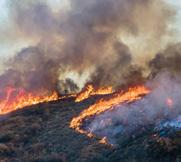
Assessing the damage of the recent California wildfires
In January 2025, wildfires devastated over 57,000 acres of land in Southern California, according to the state’s Department of Forestry and Fire Protection.
On the other side of the country, Ohio University researchers are studying the impact of these disasters, which isn’t always negative: Assistant Professor Diego Alvarado-Serrano says that natural wildfires are critical in maintaining the balance of ecosystems, acting as a natural prescriptive burn and helping decrease the chances of larger fires.
“Several ecosystems in California are particularly adapted to sporadic natural wildfires,” AlvaradoSerrano says. But, he adds, wildfires of the past were often smaller and less frequent; the magnitude and prevalence of more recent wildfires can hinder an area’s recovery.
“The recent California wildfires will facilitate only the most early and tolerant colonizer species in the areas affected,” he explains. “[The fires] will also alter the age structure of species in the community, affecting growing and reproduction rates.”
Read more about faculty research on California’s wildfires at ohio.edu/wildfires. —Emma SnyderLovera, BS ’26
New discoveries by OHIO researchers are changing history as we know it.
Ohio University faculty and fellows are at the forefront of cutting-edge research, investigating and sometimes transforming our understanding of the past. Among many revolutionary studies, two OHIO instructors recently made groundbreaking discoveries, unearthing key insights to evolutionary biology.
A team led by Associate Professor of Anthropology Sabrina Curran discovered new evidence of hominin activity in Europe, pointing to a presence on the continent far earlier than was previously thought.
“We didn’t initially expect to find much,” Curran explains. “But during a routine check of the collections, we found several cut-marked bones. This led to further investigation … and the discovery of other distinct marks across different bones, suggesting deliberate butchering activities.”

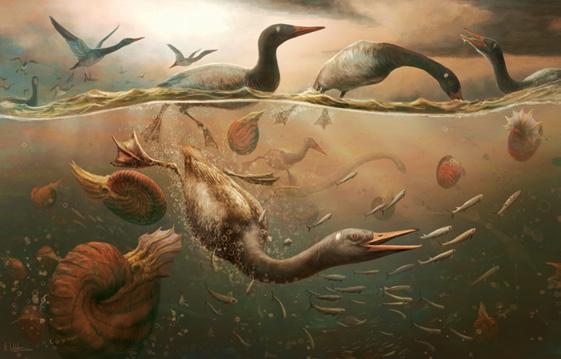
Previous research indicated hominin presence in Dmanisi, Georgia, around 1.8 million years ago, but this new finding by Curran’s team documents hominin activity in the area at least 2 million years ago—roughly 200,000 years before the Dmanisi site.
“The evidence coming out of Romania suggests that early hominins were much more adaptable than we previously thought,” she says. “These early humans were capable of surviving and thriving in a variety of environments.” Her findings were published in the journal Nature Communications in January 2025.
Just a month later, a team led by Christopher Torres published their own paper in the journal Nature, revealing their findings about an important fossil of the oldest known modern bird, Vegavis. The paper was based on a study led by Torres during his time as a National Science Foundation Postdoctoral Fellow in Heritage College of Osteopathic Medicine.
Until a nearly complete, 69-million-year-old skull was collected in a 2011 expedition by the Antarctic
Peninsula Paleontology Project—which Torres also participated in—Vegavis’ status as an early modern bird was highly contested in scientific circles. The new study published by Torres’ team contextualizes the importance of Vegavis in avian evolution and locates Antarctica as a geographic area of interest for further study of evolution.
“Few birds are as likely to start as many arguments among paleontologists as Vegavis,” says Torres, who is now a professor at University of the Pacific. “This new fossil is going to help resolve a lot of those arguments. Chief among them: Where is Vegavis perched in the bird tree of life?”
Birds known to have existed at roughly the same time in different areas of the world vary drastically from Vegavis, an early relative of modern ducks and geese, and are barely recognizable as such by modern standards. Complicating matters is the fact that many existing fossils are incomplete. As such, Vegavis is a crucial discovery in unlocking evolutionary knowledge.
—Julia Weber, BS ’25, MAA ’26

At The Ridges, Ohio University’s Outdoor Pursuits Challenge Program offers courses on the new Odessey team course, Alpine Skypark and dual ziplines. The Alpine Skypark, seen here, includes more than 10 high course elements for adventurers to traverse. The facilitated Challenge Program is perfect for teams looking to improve problem solving, collaboration, communication and other key skills. Learn more at ohio. edu/recreation/outdoor/challenge

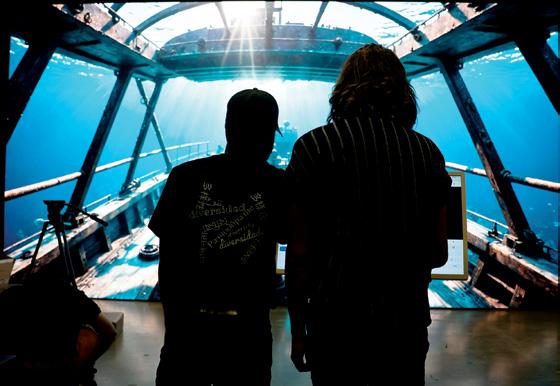
During her 2024 State of the University address, President Lori Stewart Gonzalez announced that the University would make a $2 million recurring investment to fund new faculty who would bolster OHIO’s research prominence and strengthen its academic offerings. It’s all part of OHIO’s innovative Dynamic Strategy to embrace and expand its status as a top-tier public institution of higher learning.
“Faculty are the heartbeat of the University,” says Executive Vice President and Provost Donald Leo. “They drive curricular innovation, elevate our research
capabilities and ultimately inspire student success and community impact.” He is partnering with Vice President of Research and Creative Activity Eric Muth to drive success in the Dynamic Strategy’s Discover pillar, which will grow OHIO’s research enterprise.
Leo and Muth asked the University’s academic deans to propose new tenure-track faculty lines that would support the Dynamic Strategy’s research focus areas: healthy aging, energy and the environment, and emerging fields. For the latter, a cluster emerged in artificial intelligence.
Dan Guralnik, Ph.D. (Mathematics Department, College of Arts and Sciences)
Min Lun “Alan” Wu, Ph.D. (Department of Educational Studies, Patton College of Education)
Ana Mojica Myers, MS ’08, MA ’09 (School of Visual Communication, Scripps College of Communication)
Edward Saliba, Ph.D. (Chemistry & Biochemistry Department, Arts and Sciences)
Katrina Hamilton, BA ’14, MS ’18, PHD ’19 (Psychology Department, Arts and Sciences)
Sarah Ramey (School of Dance, Chaddock + Morrow College of Fine Arts)
Tim Etheridge, Ph.D. (Department of Athletic Training, College of Health Sciences and Professions)
Aiden Payne, Ph.D. (Department of Physical Therapy, Health Sciences and Professions)
Ke Li, Ph.D. (Department of Social Work, Health Sciences and Professions)
Kristin Chamberlain, PHD ’20 (Department of Counseling and Higher Education, Patton College)
Burcu Alptekin, Ph.D. (Environmental & Plant Biology Department, Arts and Sciences)
Sara Salloum, Ph.D. (Department of Teacher Education, Patton College)
Patatri Chakraborty, Ph.D. (Department of Mechanical Engineering, Russ College of Engineering and Technology)
Learn more about OHIO’s newest faculty at ohio.edu/investment
—Emma Frankart Henterly, BSJ ’10
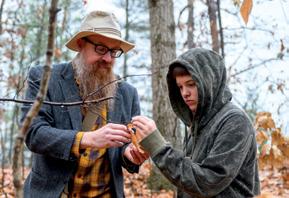

Now in its fifth year, the Fairfield County Workforce Center (FCWC)—a partnership between the Fairfield County Commissioners, Ohio University and Hocking College—is creating pathways to regionally in-demand jobs with flexible, financial aid-eligible, standalone certificates in automation, mechatronics or semiconductor manufacturing.
“What I love so much about this partnership is that we are all coming to the table with one goal in mind: serving the community,” says Lewatis McNeal, OHIO’s vice provost for regional higher education and partnerships. “A person can come get that certificate and then immediately upscale and go into the workforce. It’s helping meet the need from an advanced manufacturing standpoint.”
And the need is great. According to economic development corporation JobsOhio, the state leads the nation as a top producer of glass, plastic and rubber and is seeing increased investments in semiconductor, electric vehicle battery and solar panel production, offering plenty of opportunity for FCWC students to find employment in the area.
Read more about the nascent partnership at ohio.edu/magazine —Julia Weber, BS ’25, MAA ’26
Russ College of Engineering and Technology has invested in its aviation program with the purchase of six new Cirrus SR20 pilot training aircraft. The planes boast advanced avionics and safety features, allowing students to train with the best technology. The larger training fleet, coupled with plans to increase aviation faculty, will help reduce the program’s wait list amid surging demand for enrollment.
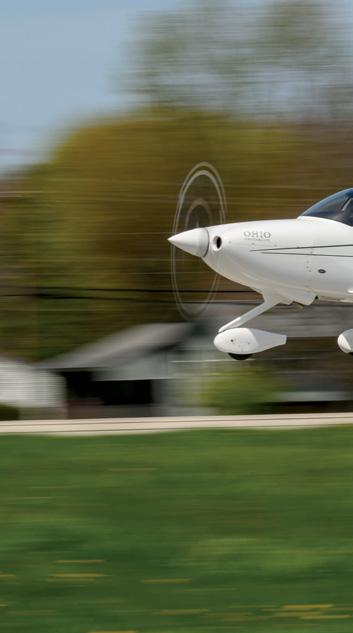
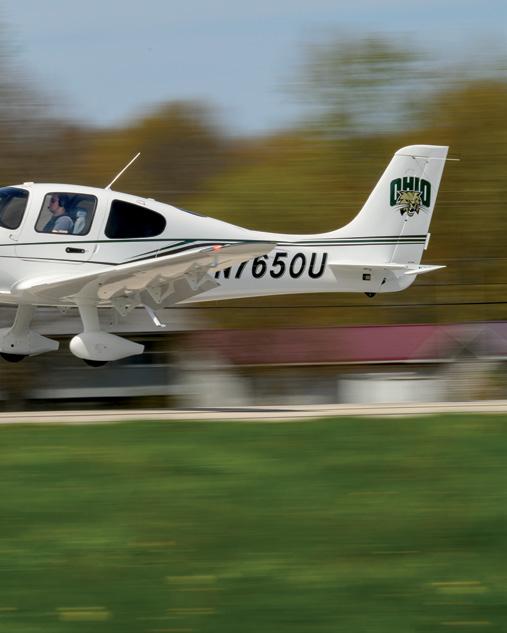

Bobcats make the news—and the OHIO community proud—every day. Read about a few of the Ohio University alumni, students, faculty and staff who have made headlines in recent months.
WE ARE THE CHAMPIONS | OHIO’s swimming and diving team finished second in the 2025 MAC Championships—with individual champion titles for sophomore Zita Szoke (50-, 100- and 200-yard freestyles) and junior Casadie DiBetta (100- and 200yard breaststroke). Szoke also set the school, pool, MAC and MAC championship record in the 100-yard freestyle preliminary; DiBetta set the school and pool record in the 200-yard breaststroke. Head coach Mason Norman took home his own title: MAC Coach of the Year. The Ohio University Dance Team (above) had similar wins at the Dance Team Union College Classic Nationals, earning their first National Championship in Division I Pom and taking second place in Division I Jazz.
IMPACT | The State of Ohio has relied on efforts from the Voinovich School of Leadership and Public Service for several key projects in recent months. This spring, it was announced that the school will craft the latest State Health Assessment, a vital compass for public health planning efforts. The Ohio Department of Health specifically requested the Voinovich School for the project, which will assess the health of Ohioans living with a disability and conduct a comprehensive review of health in the state’s 32-county Appalachian region. And last fall, Gov. Mike DeWine designated Raccoon Creek as Ohio’s 16th State Scenic River—and the first in Southeast Ohio—after restoration efforts by the Voinovich School and other local, state and federal partners.

THE POWER OF THE STAGE | The National Arts Club
awarded Professor Emeritus of Playwriting Charles Smith the 2025 Kesselring Prize for his play, “The Price of the Ticket.” The prize includes a $25,000 purse and a two-week residency at the historic Tilden Mansion near New York City’s Gramercy Park to develop his work. Judges appreciated Smith’s storytelling and the play’s deep historical and cultural insight. “His work embodies the power of theater to challenge, inspire and engage audiences,” says prize committee chair David Glanstein. Among Smith’s numerous previous works is “Free Man of Color,” the story of John Newton Templeton, OHIO’s first Black graduate, commissioned by the University for its bicentennial in 2004.
NEW BOBCATS LEADER | In September, veteran intercollegiate athletics administrator Slade Larscheid was announced as the new director of OHIO Athletics. “Slade has so many of the characteristics and experiences that we sought in a new Director of Athletics, including a demonstrated history of enhancing the student-athlete experience, valuing academics, winning championships and generating revenue,” says President Lori Stewart Gonzalez. “I have full confidence that Slade will build on our momentum.” Larscheid has previously served in athletic leadership roles at South Dakota State University and at Augustana University, among other roles. “There is something incredible going on at Ohio University,” Larscheid says, “and athletics plays a special part in its uniqueness.”
OHIO’S NATIONALLY RENOWNED CERAMICS PROGRAM ENTERS A NEW ERA
Ohio University is home to the nation’s No. 3-ranked Master of Fine Arts in ceramics and the top U.S. program outside of an arts academy. No other academic program at OHIO is more highly ranked by U.S. News and World Report, the gold standard in higher education rankings. OHIO’s reputation has been built, quite literally, brick by brick, fueled by an ever-growing and evolving cadre of atmospheric kilns designed and constructed over the years by students and visiting artists who have gone on to lead ceramics departments and fill gallery shelves around the world.
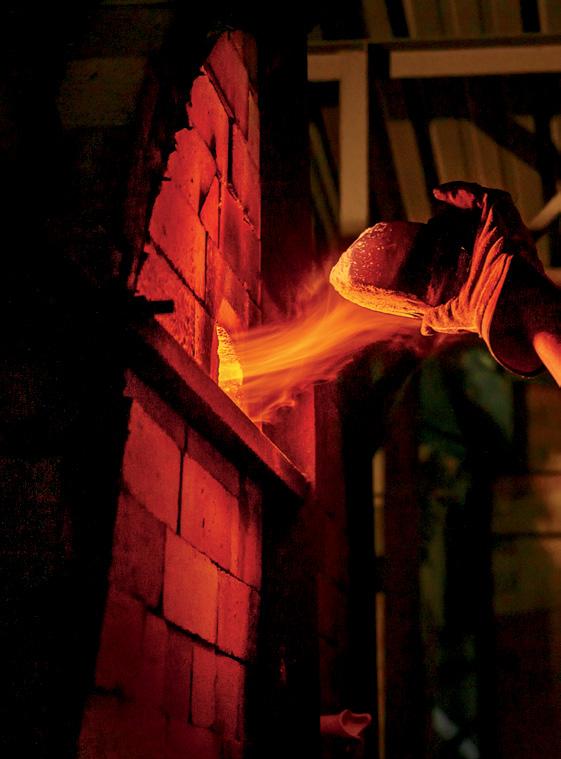

[RIGHT] Pyrometric cones, which melt at different temperatures, will be loaded into a kiln to help those monitoring the firing gauge how hot it is. [OPPOSITE PAGE] Fourth-year BFA student and Club Clay President Kylie Houghton stokes the catenary arch kiln during a 48-hour wood firing.
PHOTOS BY BEN WIRTZ SIEGEL, BSVC ’02

There’s something about fire: Its warmth, its constant movement and shifting colors, its ability to destroy but also to create and to nourish. Anyone who has spent an evening around a campfire can attest to its uncanny power to mesmerize.
So naturally, on a fall Thursday night in Athens, long after dark, the orange flames pouring out of a chimney on North Green draw curiosity. Behind a chain-link fence, you can hear laughter and a bit of chaos. A handful of students scramble to throw up a small tent as rain starts to fall.
That rain won’t deter the flames as the students continue to stoke the fire box of a catenary arch kiln filled to the brim with hand-thrown pottery and ceramic sculpture created just around the corner in undergraduate ceramics courses.
The students are damp and tired but giddy with anticipation. Behind a brick kiln door that they helped build is artwork—their artwork—in progress. As the fire burns, ash moves through the kiln and settles on the surface of their work. Their current mission is to keep the heat rising, slowly, until the kiln reaches around 2,300 degrees F and that ash melts into glass, forming natural glaze reminiscent of the fire itself. Colors range from copper to purple to soft gray. Some surfaces appear polished by the movement of air and flames inside the kiln. Others are matte and dense with collected fly ash.
“You’re basically putting a canvas—your pot—into the kiln,” says Brad Schwieger, Ohio University professor emeritus of ceramics. “What happens to it inside the kiln becomes part of the finished work of art.”
What Schwieger describes is at the heart of what is known in the ceramics world as atmospheric firing: firing with wood to create ash glaze or with salt or sodium oxide (soda), both of which vaporize and interact with the surface of the pot to create a unique and natural glaze. Unlike an applied glaze on a piece fired in an electric kiln, atmospheric firing introduces an element of the unknown. The movement of air, fire, heat and vapor inside the kiln can be partly manipulated—but never entirely controlled.
At many universities, a ceramics student might have the opportunity to fire with wood or soda once or twice, as part of a special event. At OHIO, students studying ceramics at all levels not only have the opportunity to fire in multiple different types of atmospheric kilns, but also to design and build their own, with the best being added to the structures that comprise OHIO’s kiln yard.
When Schwieger arrived at OHIO in 1990, the kiln pad was a small, 1,000-square-foot slab of concrete with a couple of kilns in desperate need of repair. He got to work building and rebuilding, with plenty of help from Robert “Boomer” Moore, who worked as a studio coordinator and kiln technician at OHIO before taking a job at West Virginia University, where he now leads the ceramics program.
When the duo ran out of space, they scraped together funds to triple the size of the concrete kiln pad and kept building. Over the years, students and visiting artists contributed, each becoming a part of OHIO’s incredible atmospheric firing story:
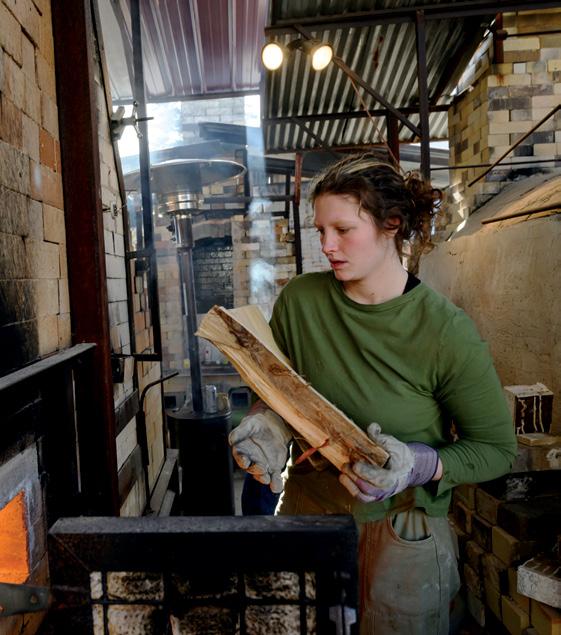
• Ted Adler, MFA ’02, designed and built a Bourry box kiln that still stands today. He now is a gallery artist and teaches ceramics at Wichita State University.
• Mike Jabbur, MFA ’08, built a small reduction gas glaze test kiln. Today he is a ceramics professor at William & Mary.
• James Tingey, MFA ’12, built a tube kiln before taking a job at Alfred University, home to the No. 2 ceramics program in the country.
• During a student exchange, German ceramic artist Jochen Dobers of Burg Giebichenstein University of Art and Design built a unique updraft salt kiln, which has a companion kiln at Dobers’ university in Halle, Germany.
“If a student or an artist comes here and has an idea for a kiln that would really support their work, we’ll build the thing,” Schwieger says. “Not everybody will do that.”
Alumni outside of the ceramics program have left their mark as well. The newly renovated building next to the kiln yard reopened this fall as the Levy Ceramics Studio, named for a gift that honors the family of Dave Levy, BS ’78, and Cathy Levy.
“Everything came together in this amazing way,” says Dave, who is also a former member of The Ohio University Foundation Board. While neither he nor Cathy are ceramicists themselves, Dave’s mother “was absolutely passionate as a potter, and it was contagious,” he recalls.
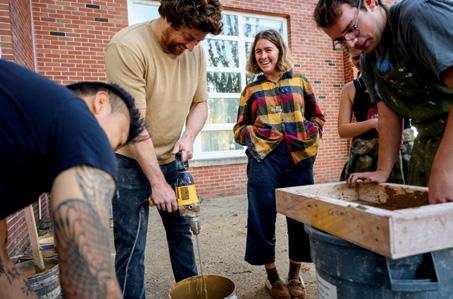
Undergraduate ceramics majors unload pots after a successful atmospheric firing.
PHOTO BY BEN WIRTZ SIEGEL, BSVC ’02
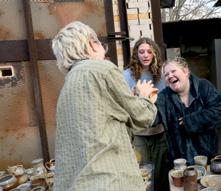
That, plus Cathy’s position on the Chaddock + Morrow College of Fine Arts Leadership Council, meant the gift “checked a lot of boxes,” Cathy adds. “It helped a fabulous program that is nationally recognized, and it’s wonderful to be associated with that. … Hopefully we’re setting an example of what people like us can do and motivating others to follow that example.”
Schwieger’s passion for atmospheric firing and “let’s build the thing” mindset defined OHIO’s ceramics program over a 30-year span. In 2009, he found a partner in Tom Bartel, who joined the ceramics faculty and brought a more sculptural approach to his work. But when Schwieger decided to retire in 2022, Bartel knew they needed to hire someone who would keep the atmospheric firing going.
Around the same time, fate brought Stuart Gair, BA ’12, back to Athens. Gair had studied history as an undergrad, but met his future wife in one of Schwieger’s ceramics classes. He fell in love with her and with clay, ending up at the University of Nebraska for an MFA in ceramics. He went on to be an artistin-residence at Harvard University and the Archie Bray Foundation, but decided to return “home” and purchase property that had once served as the Big Chimney Baking Co. This summer, Gair and his wife, Kristie (Schleich) Gair, BFA ’13, reopened the property as Canaanville Arts Center studio and gallery.
Gair’s artistic scholarship and passion had been specifically in soda firing, and he has extensive experience with various types of atmospheric kilns.
“Every pot is individualized,” says Gair, also an assistant professor of instruction in the ceramics
program, about about why he is drawn to this type of firing. “Having a pot coming out of the kiln that has a flame path on it and was placed in the kiln in a particular way to enhance the form … that’s going to create a strong connection between the maker and the vessel.
“But the main thing this kind of firing does is, it creates community. It brings people together in a way that nothing else can in terms of ceramics, or really any type of art. During the firing itself, even if you’re not on shift, people tend to hang around the kiln. ... You’re making connections with people in a different way than you would in just a classroom session.”
Gair envisions an exciting next chapter for OHIO ceramics that is even more connected to the region and is centered around artists working in community. A new student group, Club Clay, has already begun experimenting with an upcycled wood kiln at his home studio. With leadership from MFA students Jason Wang and Sam McCall, OHIO’s first Atmospheric Firing Conference took place in early June, featuring nine kiln firings by 10 artists.
As for Schwieger, he’s still making and selling pottery at his home studio and enjoying watching the next generation of leadership.
“I love seeing it all continue to grow, and I’m excited to see what they do next,” Schwieger says, adding that he’s confident the opportunity to experiment with building and firing kilns will continue to attract young artists who will leave their own mark on the program and the future of ceramics for decades to come. —Robin Oliver, vice president for University Communications and Marketing
The inaugural Ohio University Atmospheric Conference in June featured an extraordinary demonstration of OHIO’s nationally recognized ceramics program’s unique capabilities: the simultaneous firing of nine atmospheric kilns to create dozens of unique pieces over one week.
“Few, if any, other institutions could achieve what is being done here,” Ben Eberle, one of the conference’s 10 visiting artists, said at the event. “I don’t think anywhere else in the profession [has OHIO’s] collection and diversity of kilns ... and this simultaneous firing of nine kilns at once is unprecedented.”
The atmospheric kilns in OHIO’s kiln yard reflect a wide array of cultural influences and technical approaches, making each firing an exploration of history, chemistry
and artistry. Firing them simultaneously allows for side-by-side comparisons of methods and outcomes, turning the unloading of each kiln into a moment of shared insight and discovery.
“There’s an innate community-building aspect in atmospheric firing,” notes Sam McCall, MFA ’27. “It takes a village to fire these kilns.” He and Jason Wang, MFA ’25, developed the event with support from fellow students and University faculty and staff.
“In undergrad, having visiting artists come through was always super informative,” McCall adds. “Those were some really influential experiences of being able to talk and interact with those artists.” —Duane McDiarmid, director of the School of Art + Design; Julia Weber, BS ’25, MAA ’26, contributed
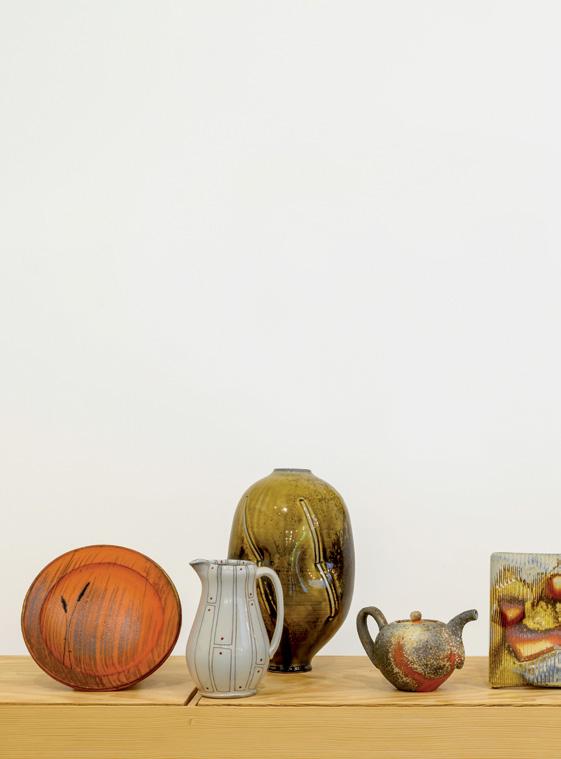
Bowl
Soda-fired earthenware
Ashton Keen: I use black dandelions and grasses to represent self. I seek to mirror my experiences of coming out with that of the stereotypical perspective on dandelions— transforming into a flower representative of resilience, adaptability and beauty.
Pitcher
Soda-fired porcelain Lorna Meaden, MFA ’05:
I am interested in having my work display both practical and extravagant attributes. I am drawn to work that is rich in ornamentation, with lavish use of materials—both scarce in a culture of mass production.
Amber Rain Vase
Soda-fired porcelain
Ben Eberle: I fire all my work in a wood-fired soda kiln. The fire path, the soda vapor and the ash that flies through the kiln create spontaneous surfaces that I have little control over. To me, that’s bonus money.
Painted By Fire 1
Wood-fired ceramic Antra Sinha: In my practice, I search for the elemental that exemplifies the oneness among all sentient beings. The Golden Spiral (present in nearly all forms of life) and the hexagon form the nucleus of inspiration for this work.
Teapot
Soda-fired stoneware
Stuart Gair, BA ’12, assistant professor of ceramics: My clays are dug locally in Athens County. By placing different shapes next to one another in anticipation of the flame flowing through the kiln, highlighted marks, muted hues, variation in color and depth is recorded on the surfaces.
Untitled Wood-fired stoneware
Brad Schwieger, professor emeritus of ceramics: Form is the most essential element in my work; secondary is developing surfaces that will enhance and support the form. I explore surface with continuous testing of ceramic materials, kiln design, kiln construction and firing.

Oval Cup
Soda-fired ceramic
James Tingey, MFA ’12: The more my work has evolved, the conceptual and technical ideas behind the piece are becoming more interwoven. This piece is an exploration of the material—how can I reuse unwanted glaze material, clay material?
Small Bottle
Wood-fired ceramic
Bryce Brisco, MFA ’11: This wheel-thrown bottle represents a confluence of inspirations. The surface is a product of the natural fly ash collecting on the pot throughout the firing and salt, which is introduced at the end of the firing.
Electric kiln-fired ceramic
Hayun Surl, MFA ’22: My work explores my cultural validity. I’m originally from South Korea. I believe culture and tradition are not static. And thinking of my individual aspect—what is my culture and tradition, and how can it move over time?
Canaanville Arts Center displayed pieces by the event’s artists through early September. Learn about the processes behind them here and in our interactive guide at ohio.edu/magazine.
Three Point Bowl
Soda-fired stoneware
Olivia Tani: I make these forms for the love of utilitarian pots, yet I am drawn to building sculpture. This piece creates an illusion of movement, which is a quality that I strive for in my designs.
Student-led sports broadcasting gives Bobcats a front-row seat to real-world experience—and a fast track to professional success.
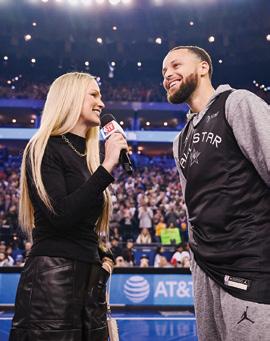
You may know Allie LaForce, BSJ ’11, as TNT’s lead NBA reporter, CBS’ March Madness color analyst or former co-host of CBS’ Lead Off with Doug Gottlieb. But before she became a household name in national sports broadcasting, LaForce lent her razor-sharp commentary to OHIO Athletics.
“[Ohio University] allowed me to walk-on the [women’s varsity] basketball team, had a great journalism program, and that was that,” she says of her decision to enroll here. “Turns out, it was the best thing to ever happen to me. The hands-on journalism experiences were next level. I was learning first-hand out in the field from the moment I stepped foot on campus.”
For LaForce and others, the E.W. Scripps School of Journalism’s sports broadcast training is a game changer. Jordan Boze, assistant athletics director of broadcast and video services, may technically oversee all OHIO Athletics and Ohio Bobcats Studios Productions—which stream through ESPN+ and the University’s YouTube channel—but the students run the show.
With few exceptions—such as some nationally televised football and basketball games—all sports broadcasts are entirely student-led and -operated, from videography and graphics to on-air reporting and directing.
“A person in my position typically leads broadcasts as the official producer or director … but I really look at myself as a steward,” explains Boze, who describes OHIO’s sports broadcasting as one of the “truest” student-led programs in the country for that reason. He joined the University to lead the program in 2022.
“Since then, we’ve done over 350 productions, involving at least 140 students,” he says, for what he estimates to be “just shy of 25,000 hours” of total experiential learning time.
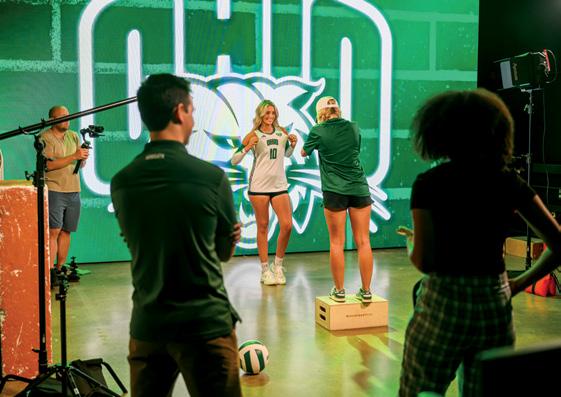
OHIO’s tradition of putting technical and creative decision-making directly into students’ hands has produced a decades-strong, self-perpetuating culture of passion, broadcasting excellence and success.
LaForce praises the support she received from both fellow students and active alumni during her time on campus. That includes Tony Castricone, BSJ ’05, now the “Voice of the Washington Huskies” at the University of Washington, who continued commuting to Athens to do play-by-play reporting for women’s varsity basketball—alongside LaForce’s color commentary—after landing his first full-time broadcast job at WBNS Radio in Columbus.
“[Castricone] actually tricked me once,” LaForce recalls. “He called in sick two hours before the game and told me I needed to set up the broadcast station
and equipment—then do both color analysis and playby-play. I was freaking out! He knew I needed to be forced to do it.”
This combination of challenge and camaraderie echoes the experiences of current OHIO student sports broadcasters. And while front-of-camera positions like LaForce’s and Castricone’s may be eye-catching, students gain meaningful experience behind the camera and in the operating booth, too.
“From my very first day, [Boze] encouraged us to learn from each other and grow together as a group,” says Sydney Holl, a fourth-year media arts production major from Akron whose work with ESPN+ includes a specialization in replay. “The more we grow into it, the more we get to start teaching others, which helps us form those bonds as a team.”
These broadcasters get their start in Boze’s Introduction to Sports Production course, which involves just one traditional class a week, plus a “lab” component working home sporting events for ESPN+. Boze maintains a spreadsheet where students can sign up for positions in camera, replay, graphics and more.
After completing the course, interested students can apply to continue supporting campus sports broadcasting on the OHIO Athletics payroll in technical, production, directing and on-air talent roles. These paid students spend long weekends setting up, operating and tearing down equipment; editing graphics; and calling game plays live on-air.
That’s when Bobcat broadcasters really hone their leadership skills and build both professional networks and lasting friendships. Colin Bacon, a fourth-year
music production major from West Chester Township, Ohio, who who minors in sports management and marketing, recently moved into his own mentorship role.
“It’s cool to see the evolution: I started off learning everything,” he says, “and now I’m learning even more, because I’m teaching it to others.”
Bobcat broadcasters also learn to trust their own professional instincts and test creative choices. “There are times in the field where someone might have an interesting new camera angle or a new graphic to throw in,” says Bacon, who specializes in video production. “We get to innovate our own ideas and see what happens.”
This culture builds collaboration over cutthroat competitiveness—though there’s still plenty of
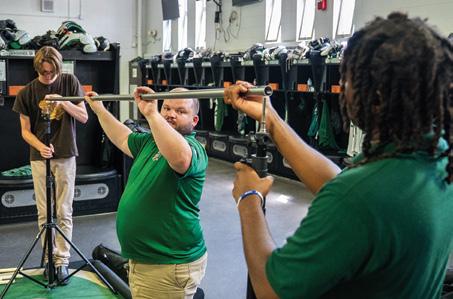
“If you give students challenges, leadership opportunities, and a clear path toward something they’re deeply passionate about, they’re going to succeed.”
—Assistant Athletics Director of Broadcast and Video Services Jordan Boze
friendly internal competition—and always, always, a commitment to excellence.
“We’ve been praised by our conference counterparts and ESPN representatives for the quality of work that we do,” Boze says, noting his students’ fierce drive to learn from mistakes and level up. “After every production, we meet as a crew and debrief on what we can do better. Often, I won’t have much to say that the students haven’t said already.”
Above all, these hands-on opportunities give students the chance to gain invaluable skills, connections and insight into what they’re capable of—all while doing something they love.
Castricone can certainly attest to that. He refers to his Bobcat broadcasting days as some of the best experiences not just of college, but of his whole life.
“Those were the beginning stages of pursuing the dream, when you’re doing it purely for love of the game, not because you’ve got to put food on the table or anything else,” he says. “Now I’m happily married to this career—but when I was first falling in love with it, that was at Ohio University.”
If you ask Boze, that love—of both sports and broadcasting—is the “secret sauce” behind the quality and popularity of OHIO’s sports broadcasting program. “If you give students challenges, leadership opportunities, and a clear path toward something they’re deeply passionate about,” he notes, “they’re going to succeed.”
—Anita Martin, BSJ ’06
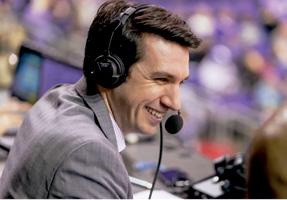
Student broadcasters can take advantage of extracurricular opportunities through WOUB Public Media, esports broadcasting and the community-owned Southern Ohio Copperheads summer baseball team.
During Tony Castricone’s first weekend at OHIO, he spoke to a fellow freshman who casually mentioned covering Castricone’s former high school in a football game on WOUB.
“I thought, ‘There’s no way that guy is doing that and I’m not,’” recalls Castricone, BSJ ’05. “So, I dived in and discovered WOUB Radio and TV, The Post, Gridiron Glory—all these resources.”
Gridiron Glory is a student-produced, Emmy Award-winning, weekly WOUB show that highlights high school football in Southeast Ohio. The public media station also runs a similar weekly show for high school basketball called Hardwood Heroes and airs student coverage of MAC Championships and other special events.
Castricone recalls recruiting friend Matt Crumpton, BSED ’04, to write what he calls “the southeastern Ohio high school football version” of CBS’ March Madness song, “One Shining Moment.” For more than 12 years, producers of Gridiron Glory played their original song of the same name over an annual video montage of regional high school football highlights.
“We stayed up all night producing and editing the season finale track—three and a half minutes of the best highlights of the year— to that song,” Castricone says. “When we got the final mixdown, the executive producer and I locked eyes, like, ‘This is awesome.’”
“Experiences like that are more than fond memories,” he adds. “They really help you push the limits of what’s possible.”
Bo Koster’s return to Athens with his band, My Morning Jacket, wasn’t just another stop on their tour—it was a meaningful reunion, both for Koster and for the city that remains a short, yet significant, part of his story.
“It felt like a homecoming,” says Koster, AB ’96. “When I look back at my degree from OU, I’m grateful for the well-rounded education it provided, [which] … opened up new avenues and introduced me to people and ideas that have made my life much richer.”
Koster’s April 2025 visit was especially poignant as the first time he’s returned to Athens since graduating—and also because it represents a celebration of the connections and experiences that shaped his career.
Although this return is a big deal for Koster, School of Media Arts and Studies Director Josh Antonuccio, BSC ’96, MED ’17, equally felt the excitement of having the band come to Athens. He also appreciated the a chance to reconnect with Koster, with whom he performed while they were both undergraduates.
“I remember listening to Pink Floyd around the time we met, a band who was huge for both of us,” Antonuccio says of those days. “Seeing Bo go to being with MMJ and then on to tour with [Pink Floyd bassist] Roger Waters was surreal. I remember being in an arena audience watching him play the intro to the iconic ‘Great Gig in the Sky.’ It was stunning, thinking of how full-circle he had come in that moment.”
For Koster, becoming the keyboardist for indie rock band My Morning Jacket wasn’t a straightforward path. Originally from Lakewood, Ohio, Koster’s first attempt at a formal music education led him to a music school after high school, but it just wasn’t the right fit. After making the difficult decision to leave, he transferred to Ohio University, reconnecting with friends and immersing himself in Athens’ music scene.


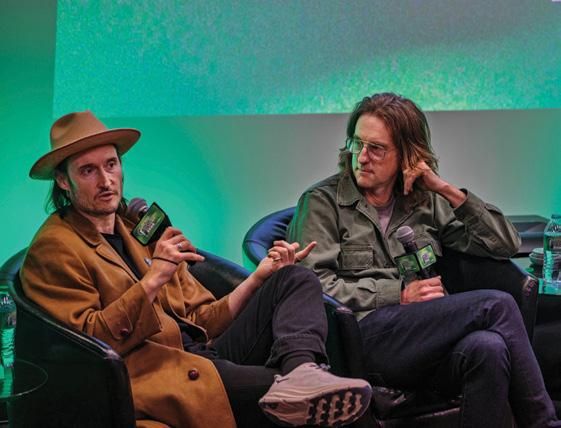
He would jam out in a small basement room in James Hall with Antonuccio and across Athens at institutions like Casa Nueva and The Dugout (now the site of Silver Serpent Exotic Gifts) with local bands, including Easy Steam Engine, dreaming of a future as a full-time musician and developing skills he would need along the way.
“I’m especially thankful for the experiences outside of music. While I consider myself mostly self-taught in music, I’ve learned that the true value of education is not in specializing, but in learning how to continuously educate and challenge yourself,” says Koster, who studied political science and economics in his undergrad years. “An education, like the one I received at OU, was the foundation for a lifetime of exploring diverse interests and growing in ways that go beyond just one field. … Regardless of whether you’re an artist or not, having a broad understanding of the world is crucial—it allows you to experience life on a deeper and more meaningful level.”
After graduating in 1996, Koster’s path took him to Los Angeles, where he pursued various musical opportunities and worked on eclectic projects, playing with everyone from jazz and hip-hop musicians to acclaimed artists like Mike Garson. But a chance conversation at a party led to an invitation to audition for My Morning Jacket, which had formed in 1998 and needed a new keyboardist.
Koster joined the band in 2003 and first appeared on their 2005 breakout album Z. After that, his career skyrocketed. He toured the world with My Morning Jacket, played alongside the likes of Roger Waters and Ray LaMontagne, and contributed to albums that became pillars of indie rock.
Over the years, Koster and Antonuccio lost touch, each forging their own paths in the music world. (Read more about Antonuccio’s on page 56.)
But life has a funny way of bringing people back together, and the pair reconnected about 10 years ago, when My Morning Jacket was touring through Columbus. In the years to follow, the idea to bring the band to Ohio University, specifically the Music Industry Summit, began to take shape.
“Bo was always such an incredible musician, and I have loved seeing all he’s accomplished,” says Antonuccio, who is also the director of the Music Industry Summit. “As the Music Industry Summit has grown, we are always looking at ways to bring back our alumni in the creative industries. It’s about creating opportunities for students to learn directly from people who have made it in the world. So we thought, why not try go get Bo and My Morning Jacket back to OHIO?”
Getting any major artist to Athens is no simple task, however, and My Morning Jacket was no exception. Touring bands have countless variables, from album releases to travel schedules, but after working for nearly a year to make it happen, the timing finally aligned.
“Josh and I have been talking about this for years—it’s always tough to get the schedule to work, and Athens is not your typical tour stop,” Koster says. “It had to be the right time and fit into our touring schedule. We never quite figured it out until recently when he mentioned doing a keynote speech and a show. That’s when I said, ‘Finally, we’re doing it!’”
Although scheduling My Morning Jacket for the 2025 Music Industry Summit in March didn’t work out and the band had a packed tour schedule promoting the release of their new album, is, they were eager to find time to connect with the Athens community and OHIO students. Antonuccio and his team identified a special opportunity for a one-off event: On April 17, My Morning Jacket performed at Templeton-Blackburn Alumni Memorial Auditorium, hosted by the Music Industry Summit and OHIO Live.
“It felt a bit surreal [coming back to Athens], like I was going back in time,” Koster says. “It was also heartwarming. So much of my musical and personal identity was influenced by my time in Athens, and
it felt great [performing in Mem Aud]. It was such a perfect Athens day. The vibes were great. I spent some time walking all over campus … and reminisced about my life and how I got there. The show was stellar, and we really felt the love in the room. I feel incredibly lucky to have had that full-circle moment with my band and friends. Lots of gratitude.”
The band also engaged in a conversation with Stereogum managing editor Chris DeVille, BSJ ’06, at the Athena Cinema the night before the show, where they discussed their new album and how they got to where they are today.
“It was nice to share those experiences with students and people from the community,” Koster says. “Hopefully it inspires people to make their own way in the world, or maybe it helps them parent children with creative aspirations. It’s incredibly valuable for young people to hear how others have navigated their way through life and found their calling. At 18 or 19, it’s hard to know what you’re supposed to do, and I feel lucky that I knew I was drawn to the piano and music. It felt like I didn’t have a choice in the matter. I enjoy sharing that with younger people—what it takes, how it happens, and how they can carve their own path to find their niche in the world.” For the students who attended the conversation or concert, Antonuccio hopes the experience conveyed a message of persistence and passion.
“Bo’s story is a great example of how you have to take risks and follow what matters to you. He went to LA, and that’s where things really took off. You never know what will happen when you follow your heart,” he says. “And Bo’s story with MMJ is not just about the music—they’ve built a fan community, a loyal following that understands the ethos of the band. They’re a reminder that if you do things right, it can resonate with so many people.”
As My Morning Jacket wraps up their tour this fall, Koster continues to embrace the unpredictable nature of life on the road. And though his career has taken him all over the world, he is grateful it has brought him back to Athens, if only for one night. —Samantha Pelham Kunz, BA, BSJ ’17, MAA ’21
OHIO is addressing health disparities in Appalachia—and training students to do the same in rural settings statewide.

It’s a Thursday morning at the Heritage Community Clinic in Grosvenor West, where Justin Richards just finished his second medical appointment of the week. Richards grew up here in Athens and now works contracts lasting months to years on oil rigs throughout the country. He failed the physical exam required to start his next assignment; his blood pressure was too high. Between jobs and lacking health insurance, he Googled “free health clinic” and found this no-cost option made possible by OHIO’s Heritage College of Osteopathic Medicine’s Community Health Programs, along with funding from the Osteopathic Heritage Foundation and others.
“It saved me. I’m really not in a position where I can [pay] out of pocket right now,” he says. “I’ve gotten better treatment here and care here than from places I went when I’ve had insurance. … They’re such nice people.” He received diet advice, a blood pressure cuff and a prescription for medication and was on his way to passing his physical and starting his next job in just over a week.
Richards is by no means the only happy patient at this clinic that in 2024 was named the state’s Free Clinic of the Year by Charitable Healthcare Network. That year, it served more than 6,000 individuals—qualifying adults ages 18 to 64 who are uninsured or underinsured. In patient satisfaction surveys, 100% of respondents said they felt that clinic staff cared about meeting their basic needs.
Importantly, 91% reported that they would have delayed or not received medical care without the clinic. Nationwide, many rural areas like Southeast Ohio are considered medically underserved, meaning there are not enough services or primary care providers to meet the health needs of the population. In fact, the American Journal of Managed Care estimates that more than 90% of rural counties are facing a shortage of primary care physicians. Ohio University is at the forefront of tackling this crisis. As just one example, last program year, 181 Heritage College medical students spent time in the Heritage Community Clinic for their community-clinical experiences.
In addition to lack of insurance and poverty, lack of transportation is a factor that can prevent rural residents from receiving health care. Enter Heritage College mobile clinics, which provide primary care, sexual health and wellness, women’s health and more. Mobile clinics regularly visit sites in Athens and surrounding counties.
“Being a medical home and having as many primary care patients as we do now, we need to be in those counties more often,” says Perry County native Carole Merckle, BSN ’10, MSN ’18, director of clinical operations for the Heritage Community Clinic.
Merckle’s language—medical home—is a testament to the way she and her staff think of their patients. Merckle points to Appalachian culture that can have a distrust of outsiders until there is an established relationship and trust. “Honestly, I feel like the trust is pretty well built for most of our patients, probably at appointment No. 1,” she says.
Providing patients what they need outside of the exam room is another way Community Health Programs and the Heritage Community Clinic create relationships that build trust. For example, it’s now the third Tuesday of the month, meaning it’s food pantry distribution day at the clinic.
In 2023-24, this pantry gave out the equivalent of nearly 43,000 meals. It’s a “choice” pantry, which reduces food waste by allowing clients to select items to take home. Many are here specifically for the meat, fresh fruits and vegetables, and personal hygiene items. Informational flyers cover tips for healthy eating and details on other clinic services, like diabetes screenings, and “wraparound” services include professionals from Athens County Job and Family Services, who can help patients with other issues like finding jobs, child care and transportation.
“Our students who are going to be physicians will see patients who maybe don’t show up for an appointment,” says Heritage College assistant
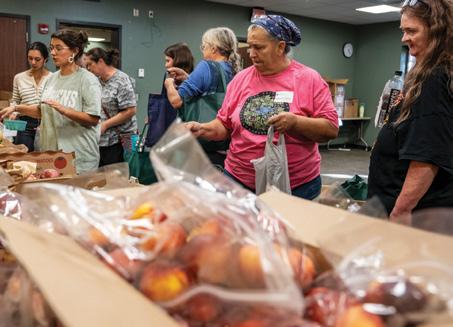
professor of primary care Sharon Casapulla, EDD ’12, MPH ’19. “In their training, if they learn one of the reasons they don’t show is because of child care or because of transportation … they can connect their patients with those resources.”
Along with the food pantry and its free clinic, Community Health Programs’ Family Navigator Program offers free baby supplies, from diapers to clothing to bottles, and uses evidence-based practices to provide free education and support for Medicaideligible pregnant clients and their families.
According to U.S. News & World Report, Ohio University is the state’s largest provider of primary care physicians; for number of graduates practicing in rural areas, OHIO is No. 1 in the state and No. 21 in the nation. Still, there simply aren’t enough physicians to meet the health
care needs in many rural areas, so physician assistants, family nurse practitioners and other advanced practice registered nurses provide a critical role in filling primary care gaps. Fortunately, OHIO is a leader in those areas, too. In just the last year:
• The Master of Physician Assistant Practice (MPAP) program was ranked No. 1 among public institutions in the state of Ohio and No. 119 nationally by U.S. News & World Report.
• The online Bachelor of Science in Nursing to Doctor of Nursing Practice (BSN-DNP) was ranked No. 2 in the country by AllNurses.com.
• The online Master of Science in Nursing Family Nurse Practitioner (MSN-FNP) program was ranked No. 1 in Ohio by both RegisteredNursing.org and Nurse Practitioner Online.
When practicing nurses apply for OHIO’s MSN-FNP program, they are asked on their application 1) Why FNP, 2) Why OHIO, and 3) Why now?
“Their ‘why’ is uniquely personal, and often they will say, ‘I live in a rural community in XYZ County, and there are not primary care providers or there is one primary care provider,’” says Char Miller, executive director and associate professor in the University’s School of Nursing. “Our students are frequently returning to those communities post-graduation to help address that shortage.”
In short, identifying rural residents who may want to pursue careers in the medical field tends to be more effective than trying to get medical providers to move to rural areas. This is where OHIO’s recent expansion of its nursing degree programs comes in.
All five regional campuses now offer a BSN, and community health clinicals in those campuses’ communities include vaccine clinics, public health education and health screenings. And in February 2025, the J.W. & M.H. Straker Charitable Foundation Nursing Wing opened at OHIO Zanesville with advanced practice labs, cutting-edge simulation spaces and more to help train nursing students to provide safe, effective care. The curriculum emphasizes the needs of vulnerable populations like those in rural areas. “On regional campuses, by and large, [graduates] stay in those communities,” Miller says.
OHIO also offers standalone, post-graduate nursing certificates—including an emergency nurse practitioner certificate, new this fall—and both MSN and DNP degrees, which train advanced practice nurses in primary care, psychiatric medicine, gerontology-acute care or nurse anesthesia.
With the National Council of State Boards of Nursing predicting that nearly 40% of nurses will leave the workforce by 2029, OHIO’s School of Nursing prepares nurses to stay in the field by teaching essential clinical skills and setting realistic expectations for both the challenges and rewards of
a nursing career. Completion rates for the BSN program are typically 90% or higher, compared to the national average of 80%.
OHIO’s MPAP program at the Dublin Integrated Education Center in Central Ohio, which celebrates its 10th anniversary this year, has similar student success outcomes. The classes of 2023 and 2024 each had 100% first-time pass rates for the Physician Assistant National Certifying Examination (PANCE); nationally, first-time pass rates were 92% and 94% in 2023 and 2024, respectively. The 27-month program emphasizes primary care in medically underserved urban and rural communities, preparing gradates for careers in a field with growing demand: According to the U.S. Bureau of Labor Statistics, PA employment is projected to grow 28% from 2023 to 2033—faster than average across all occupations.
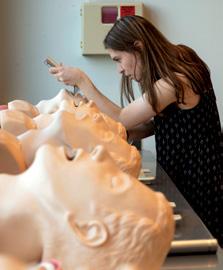
Heritage College doesn’t simply provide the infrastructure to deliver health care and social supports to rural patients; it trains the next generation of physicians who will care for them.
Closely aligned with the Community Health Programs is the Consortium for Health Education in Appalachia Ohio (CHEAO), a federally funded Area Health Education Center (AHEC) that helps recruit, train and retain well-qualified health care professionals in rural and underserved areas by sponsoring continuing education for physicians and nurses, coordinating on-site clinical training for Heritage College students, organizing health care career fairs and more.
The college also has specific initiatives to prepare rural primary care physicians, including the Rural Experience in Appalachian Community Health (REACH). The fourweek program immerses students in rural community health at the end of their first year, emphasizing the connection between public health and medicine through clinical residency and engagement with local nonprofit social support organizations.
Another program, Rural and Urban Scholars Pathways (RUSP), is a co-curricular learning community that prepares students to work in medically underserved areas, both urban and rural, through yearlong, longitudinal, integrated clerkships. Its graduates practice in rural areas at twice the national average.
“One of the things that HCOM specifically is good at ... is community partnerships,” says Casapulla, who also serves as RUSP director and president of the Ohio Rural Health Association. “A lot of these challenges that we’re talking about with health care can’t be addressed by one entity alone. It’s not for medicine to solve; it’s not for public health to solve. All of the different organizations and institutions in a community need to be thinking about how to address it and how to work together.”
Kasey Roush, DO ’25, worked both as a pharmacy tech and a medical assistant for five years in Gallia County prior to medical school; like others, she was already dedicated to rural health care when she enrolled at Heritage College. She participated in RUSP and learned
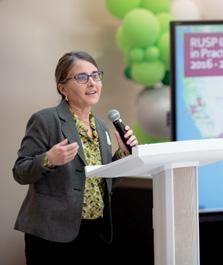
what she wanted—and didn’t want—to do with her future as a primary care physician in Southeast Ohio. Still, particular situations could be challenging. This is where another feature of RUSP came through for her: Clinical Jazz.
Clinical Jazz is a monthly, small-group peer session composed of medical students in different cohorts, plus professional facilitators. At meetings, students can share a difficult situation they’ve experienced to get feedback and coaching. Roush presented her quandary to the group: A patient from her past relapsed and died. “It really bothered me, and I was like, ‘Should I go to his funeral?’” she explains. “Where is the line?”
One of Roush’s facilitators was Dr. Randall Longenecker, assistant dean emeritus of Rural and Underserved Programs, who was instrumental in developing RUSP. He had ready advice for her. “He said he went to many funerals because it’s a community, too, with rural medicine,” Roush recalls. “You’re part of the community.” —Mary Reed, BSJ ’90, MA ’93
“Whoever begins to read Kazantzakis cannot stop.” —Elie Wiesel
In a literary journey that bridges continents and centuries, Ohio University Press is bringing the spirit of Greece to Appalachian Ohio with the release of two newly translated novels by renowned Greek author Nikos Kazantzakis: “Alexander the Great” and “At the Palaces of Knossos.”
Kazantzakis, who also wrote “Zorba the Greek” and “The Last Temptation of Christ,” was a 20th-century literary titan. Now, thanks to fresh translations by Niki Stavrou—Kazantzakis’ granddaughter and a devoted steward of his literary legacy—his imaginative writing is being introduced to a new generation of readers. And where better to publish these stories than in Athens—Ohio, that is.
“Alexander the Great” follows the legendary conqueror from his boyhood in Macedonia to the farthest reaches of his empire. Narrated through the eyes of a trusted companion, this sweeping epic chronicles Alexander’s legendary life story, blending history, myth and philosophy to portray him as both human and divine. “At the Palaces of Knossos” is a vivid account of the Minoan civilization’s rise and fall. Following Theseus, Ariadne, Daedalus and Icarus, the plot explores power, freedom and fate on the rugged island of Crete.
The covers of both novels were designed by publicity assistant Jenna Reitz, BSVC ’25, during her senior year, showcasing the Press’ commitment to providing students with hands-on learning and professional development.
“Our student interns are a vital part of our publishing program, expanding their talent and OHIO education into transferable skills in a live publishing house,” says Beth Pratt, director of Ohio University Press. “These cover designs are an example of a fresh Bobcat perspective on two perennial bestselling titles.”
The Kazantzakis books are a testament to what’s possible when ancient stories meet modern minds, right here in Athens. —Laura M. André, publicity and metadata manager at the Ohio University Press
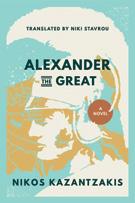

At OHIO, alumni support is transforming student experiences across campus, from labs to the stage. One exciting avenue donors can direct their giving to is experiential learning funds, which assist students in gaining hands-on experience in their fields.
“Experiential education is one of the cornerstones of President Lori Stewart Gonzalez’s Dynamic Strategy,” says Greg Simmons, vice president for University Advancement and president and CEO of The Ohio University Foundation. “Philanthropic support significantly increases the likelihood that students can engage in invaluable, hands-on experiences where they can put theory to action, develop critical leadership skills, and prepare for meaningful careers upon graduation.”
The Russ College Bobcat Baja Project Support Fund, which launched during Giving Day this spring, is just one example of the many experiential learning funds that donors may back. Its beneficiary, the Bobcat Baja SAE team, is a student organization that designs, engineers and pilots an off-road vehicle for the annual Baja SAE (Society of Automotive Engineers) competition.
The Bobcat team, which has more than 40 members, aims to create an interdisciplinary and inclusive environment that gives students the opportunity to collaboratively apply their scientific and creative knowledge gained in the classroom in a fun, real-world scenario.
During the engineering process, the team must show that they defined a specific design problem, set goals and requirements, and effectively designed a vehicle that met those needs. They use CAD software to create models and run simulations, then manufacture and build the vehicle, a buggy, in order to test the design in the real world and finalize it for competition.
“At the competition, we bring a lot of documentation of our design and everything we have prepared,” says
Alec Sebrell, team president. “It’s not just putting something together and calling it a day; there’s actual engineering. The competition is our chance to show what we’ve learned.” Now a senior studying electrical engineering, Sebrell was a member of the team that took home first place in the sled pull category of the May 2023 Baja SAE competition.
The support fund, through which the team raised about $2,700 this year, allows more members of the team to attend the competition and see their hard work pay off, compared to years past.
“That [amount] will take about nine more people with us, so we’re super excited to see that,” Sebrell says. “We’ll be able to take almost everybody who wants to go to competition.”
The fund also supports the preparation that the team is doing over the summer, such as holding “work weekends” for students to help construct the team’s buggy. After completing the frame in the spring, summer projects include attaching the engine, steering, suspension and other components.
Jacob Mizer, a senior studying mechanical engineering and treasurer of the Bobcat Baja team, notes the importance of the Russ College Bobcat Baja Project Support Fund and Russ Vision Funds—another philanthropic avenue for donors—to the Bobcat Baja team.
“[Donors have] allowed Bobcat Baja to continue to provide the hands-on learning experiences … that allow our members to both apply their classroom knowledge as well as develop the foundational manufacturing knowledge needed to become better engineers,” he says. —Emma Snyder-Lovera, BS ’26
Support this fund at give.ohio.edu/baja, and find other experiential learning opportunities at ohio.edu/experiential.

Donor support for experiential learning funds at OHIO helps provide hands-on educational opportunities for students, like those on
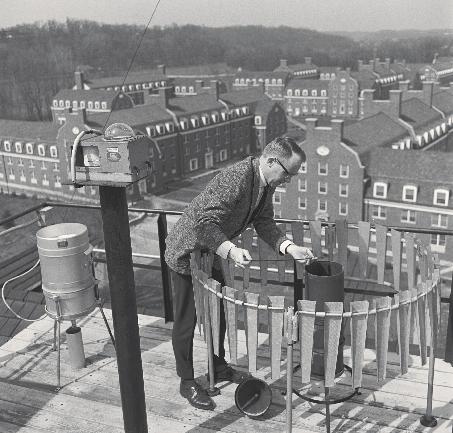
Student-centered lab has provided local forecasting since 1984
Last year, the Scalia Laboratory for Atmospheric Analysis celebrated 40 years of providing weather forecasting services for Ohio University and the surrounding community. From its home in Clippinger Laboratories, undergraduate students can gain hands-on experience with real-time forecasting—and in fact earned OHIO the StormReady University designation from the National Weather Service in Charleston, West Virginia, this year in recognition of their efforts to warn the public of hazardous weather. The lab also offers research space
for both undergraduate and graduate students and conducts community outreach at local schools and in partnership with the National Weather Service (NWS).
While Scalia Lab was officially founded in 1984, its roots date to 1981 with undergraduate students John Coulter, BS ’83, and Mark Miller, BS ’82. The two would visit the weather observations platform atop Porter Hall and tune into the NWS forecast from Pittsburgh. Using this and local weather coverage and observations, they

would prepare a forecast and record it on an answering machine. The project quickly expanded in response to demand, logging over 100,000 calls in its first year of operation. The lab’s namesake, Tim Scalia, was a pre-meteorology freshman who died in a car accident in April 1980.
“The lab has a really impressive history of students getting this passion, talking to a faculty member who provided a little bit of funding, and then taking it and running,” says lab director Ryan Fogt, also a professor in the College of Arts and Sciences’ Geography Department. “It has always been, and is today, a student-centered lab.”
Today, Scalia Lab still provides forecasts by phone (740-593-1717), as well as on its website and social media platforms. Meteorology student staffers fall under three disciplines: physics, geography and broadcasting, the latter a collaboration between the College of Arts and Sciences and E.W. Scripps School of Journalism that began in 2020 and is one of eight undergraduate programs for broadcast meteorology in the country.
“It is a challenge to blend in science and journalism,” Fogt says. “We’re providing students with both of those experiences as an undergraduate, and they’re landing jobs right away in the field because there’s so much demand.” —Emma Snyder-Lovera, BS ’26
Class Notes
* denotes accolades featured at ohio.edu/news or in the media
The Ohio chapter of the United States Harness Writers Association inducted Donald “Skip” Hoovler, BA ’65*, as the 51st member of the Ohio Harness Racing Hall of Fame in January. Hoovler became involved in harness racing in 1968; he is a longtime owner and has served in leadership roles for several industry associations over the years.
1969
Haywood Handmade Gallery in Waynesville, North Carolina, hosted a curated solo exhibition by Ann Miller Woodford, BFA ’69, this spring. Woodford is a celebrated artist and author making work about emergence and empowerment in a variety of mediums.
The Society of Experiential Education (SEE) honored Roseanna G. Ross, BSED ’71, PHD ’82, with the John S. Duley Lifetime Achievement Award at the organization’s annual conference last fall. Ross was recognized for her contributions to the field of experiential education, dedication to advancing its principles, and for her contributions to developing SEE programs over the past four decades.
Author and U.S. Army veteran Patrick McLaughlin, BGS ’72, was elected as chair of the Ohio Board of Professional Conduct. He has been a board member since 2017, previously serving on its Rules and Advisory Opinion committees and as vice chair from 2023 to 2024.
The documentary photography of Ken Light, BGS ’73, was on display at the Bronx Documentary Center last fall in an exhibition titled American Stories: 1969-1995. For more than 50 years, Light’s black-and-white photography has aimed to shed light on social justice issues in the U.S.
Joseph Pilotta, MA ’73, PHD ’77*, received the Albert Nelson Marquis Lifetime Achievement Award in honor of his many years of professional accomplishments as a college professor, author of more than 30 titles, and managing partner at In-Nova.1 and China Alliance Partners.
Michael Catheline, AB ’78, MA ’82, retired after 46 years as an educator. He’s spent the last four decades working for the State of Ohio, teaching in
A crunch heard ’round the country

Directed by Collin Black, BSC ’21*, a team of Bobcats became one of 25 finalists for the Doritos “Crash the Super Bowl” ad campaign, gaining national exposure when their commercial found a spot on the company’s website in early 2025.
“It was just so cool to get that kind of recognition,” Black says. “We didn’t make it to gain this recognition; it was about doing something creative with friends and pushing the boundaries of what we could do.”
The 30-second, Trojan horse-themed ad was created by Black and several fellow OHIO alumni. Watch the result and a behind-the-scenes look at its creation at ohio.edu/doritos
juvenile and adult correctional institutions.
Detroit Lions assistant athletic trainer Joe Recknagel, BS ’78, retired this spring after 45 years with the team. He started his career with the Lions as a summer intern in 1977 and was hired fulltime in 1980, becoming one of the longesttenured athletic trainers in the NFL.
Vanessa Bell Calloway, BFA ’79*, starred in the BET+ original movie “Queens of Christmas.” A member of Alpha Kappa Alpha Sorority, she has been featured in many movies and TV shows throughout her 40-year career.
John D. Elliott, BFA ’79, retired from a career as a U.S. Foreign Service officer. He now lives in Ocala, Florida, with his family and directs several nonprofit groups that he founded. His photography has been exhibited in galleries across four continents, including this year’s solo exhibition The Human Pulse at the College of Central Appleton Museum of Art.
1982
The College Football
Playoff Selection Committee appointed former Michigan State University head coach Mark Dantonio, MED ’82*, as a member for a threeyear term last spring.
1984
The Ohio University Center for Sports Administration named Jon Steinbrecher, MSA ’84*, as the 2025 Charles R. Higgins Distinguished Alumnus. Steinbrecher is commissioner of the MidAmerican Conference and is the only person to have served as commissioner in all three NCAA Division I subdivisions.
1987
In March, Linda Bailiff, BBA ’87, MPA ’90, of Granville, Ohio, was reappointed as director of the Ohio Public Works Commission for a term ending March 18, 2029.
John F. Madden II, BS ’89*, recently became the 63rd member of the Middle Atlantic PGA Hall of Fame. Madden began his golf career in 1989 after graduating from OHIO, where he played on the men’s varsity golf team. He was named the 2016 MAPGA Golf Professional of the Year, served as the 46th MAPGA president from 2014 to 2015, and was a district director on the national
PGA Board of Directors from 2019 to 2021.
OhioHealth Grant Medical Center in Columbus named Dr. Le-Ann M. Harris, BSH ’90, MHSA ’92, BSN ’08, its new chief operating officer. Most recently, she served as chief nursing officer and vice president of patient care at the center, with previous positions as its director of nursing and chief nursing officer and as vice president of patient care at OhioHealth Morrow County Hospital.
Cathleen “Cathee” Mang, MAIA ’92, recently signed with Adler and Associates Entertainment, Inc. for the second film she wrote, produced and directed about Balinese masked dance drama, “Dancing Faces of Bali 2.” Her first feature documentary, “Dancing Faces of Bali,” is available on Amazon Prime Video in the U.S. and the U.K.
Last fall, Margaret “Peggy” Dillon, MSJ ’94, PHD ’97, taught undergraduate and graduate journalism and writing courses as a visiting professor at Jagiellonian University in Kraków, Poland. She is a professor emerita of media and communication at
Alumni Authors
OHIO alumni publish books across subjects and genres. Here are releases within the last year.
The Texas Murders: A Texas Ranger Thriller, western (Little, Brown and Co.), by James Patterson and Andrew Bourelle, BSJ ’97, and Shot Clock, sports/thriller (Severn House), by Andrew Bourelle, BSJ ’97 · Royal Roots: Reimagining a Life through Humor, a Castle, and the US Navy, memoir (self-published), by Patricia Wynn Brown, BSHSS ’73 · Such Great Heights: The Complete Cultural History of the Indie Rock Explosion, pop culture (St. Martin’s Press), by Chris DeVille, BSJ ’06 · The Couch in the Yard, children’s picture book (Penguin Random House), by Kate Hoefler, BA ’01 · The Endless Sphere of Time, poetry and photography (True North Editions), edited by Kate (O’Grady) Jordahl, MFA ’82, photos by Geir Jordahl, MFA ’83 · How to LOVE Sales: A Framework to Build Confidence and Success, business/self-help (Kesig Enterprise Solutions), by Paul Kesig, BBA ’05 · Power of the Pony, children’s book (self-published), by Heidi Nyland Melocco, MS ’02, and Savannah Melocco · Everyday Ecofascism: Crisis and Consumption in American Literature, climate change and political science (University of Minnesota Press), by Alexander Menrisky, BSJ ’12 · Womb Witch: Herbal Magick for Reproductive Health, herbalism and self-care (Microcosm Publishing), by Angelica Merritt, BSJ ’12 · Where We Love, fiction (self-published), by Mary Bell Meyer, AB ’72 · Hannibal Lokumbe: Spiritual Soundscapes of Music, Life, and Liberation, biography (Columbia University Press), by Lauren Coyle Rosen, BSJ, BA ’05, and Hannibal Lokumbe · Draven’s Run, science fiction (self-published), by Glenn Somodi, BSJ ’92 · Edison Goes to Washington, children’s book (self-published), by Kristin Strobel, BA ’07, MA ’08 · Unseen Scars, poetry (self-published), by Martin Terrell, AA ’79, BA ’86, MS ’91 · GURPS Monster Hunters Adventure: The Face of Fire, RPG adventure guide (Steve Jackson Games), by J. Edward Tremlett, AB ’93, BSC ’96, and Christopher R. Rice · Jurita’s Song: From Dust to Destiny, historical fiction (self-published), by Vern Turner, BS ’66
Send your published work updates to ohiotoday@ohio.edu or to OHIO Today Magazine, Ohio University, P.O. Box 869, Athens, OH 45701-0869. And don’t forget to add your achievement to the Ohio University Alumni Association’s Bobcat Authors database at ohio.edu/alumni/bobcat-authors.
Salem State University in Massachusetts, from which she retired in May 2024.
Law firm Flannery Georgalis, LLC, announced its hire of former U.S. Attorney William “Bill” Ihlenfeld, BSJ ’94, as partner-in-charge. Ihlenfeld resigned from the Department of Justice in January and will lead the firm’s expansion into West Virginia with the opening of three new offices.
A prosecution team that included Assistant U.S. Attorney Brian S. Deckert, AB ’96, was honored with the John Marshall Award for Excellence in Litigation for its work on United States v. Aimenn Penny, regarding the 2023 firebombing of a church in Chesterland, Ohio.
The award, one of the Department of Justice’s highest recognitions, was presented at the 72nd Annual Attorney General’s Awards in Washington, D.C., early this year.
The Western States Communication Association presented Alena (Amato) Ruggerio, BSC ’96, MA ’97, with the 2025 Distinguished Teaching Award for her work at Southern Oregon University and scholarly contributions to communication pedagogy.
The Athens-HockingVinton Alcohol, Drug Addiction and Mental Health Services (317) Board awarded Dan Brozak, BA ’99, the Behavioral Health Advocate Award for Athens County. The
award recognizes his extraordinary work as a hospital liaison at Hopewell Health Centers.
Jeffrey Allen, BBA ’03*, made history this year when he took home a $10 million prize, the largest in entertainment history, as winner of reality competition show Beast Games. Shortly after, he completed “Ruck 4 Rare,” a 365-mile expedition to raise money and awareness for creatine transporter deficiency, an ultra-rare genetic disorder that affects his son.
The Boston Theater Critics Association nominated Sharath Patel, BFA ’03, in the “Outstanding Sound Design, Large” category of the 42nd annual Elliot Norton Awards for his
work on “Diary of a Tap Dancer” at the American Repertory Theater.
In February, the Puget Sound chapter of the American Marketing Association elected Holly Prouty, BSC ’05, MED ’08, to serve as a volunteer board member and vice president of communications. Professionally, she is a system communication manager of CRM communication and strategy at Washington State University.
Cleveland Magazine named Stephanie Haney, BA ’06*, one of its Most Interesting People of 2025. A licensed attorney in both Ohio and California, Haney serves as a digital anchor, report-
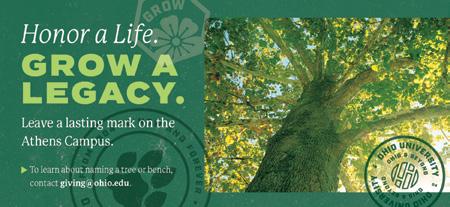

Steve Krebs, BSISE ’92, enjoyed OHIO Today Magazine on a recent trip to China. He was visiting Shanghai to celebrate the 30 th anniversary of AlpHa Measurement Solutions, the wholly owned Chinese subsidiary where he serves as chief operating officer.
From left, Catie PerezStrohmeyer, BFA ’25, and mother Pam Schmidt, BSRS ’90, braved the weather to show their OHIO pride at Ireland’s Cliffs of Mohr.
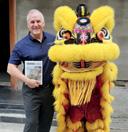
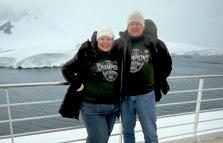
James “Jim” Merkowitz, BSED ’82, and Rose (Fisher) Merkowitz, BSHEC ’81, MSHEC ’86, showed their OHIO pride on a recent trip to Antarctica. They have now traveled to all seven continents, including 40 countries and all 50 U.S. states.

Celebrating more than 10 “OU Fest” reunions nationwide, these Bobcats chose Montana and Wyoming for their June 2024 gathering. Pictured near Red Rock Point along the Grand Canyon of the Yellowstone are (from left) Mike Wuertzer, BSISE ’93; John Maximuk, BS ’92; Doug Sherwin, BSJ ’92; Neil Schmidt, BSJ ’93; Brent Neal, BSJ ’92; and Bryan Mosher, BS ’92
Ruud van Dijk, PHD ’99, from the Dutch island of Vlieland, greets Joe, Bill, Lance, Becky, Dan and other members of the early 1990s water polo team.


Twin sisters Patty (Trumpeter)
Lovell, BSRS ’82, and Priscilla “Polly” (Trumpeter) Moss, BSC ’81, brought a little extra Ohio spirit to the Cleveland Guardians spring training in Goodyear, Arizona, in March 2025.
Send your photos with names, grad degrees and years to ohiotoday@ohio.edu or to OHIO Today Magazine , Ohio University, P.O. Box 869, Athens, OH 45701-0869.
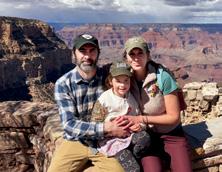
Ezra Shearer, BA ’06, MED ’10, and Monica Perez-Watkins, BS ’06, made sure they and their 5-year-old daughter, Adria, were well protected from the sun and sporting school spirit during a recent trip to Grand Canyon National Park.
Send your photos with names, grad degrees and grad years to OHIO Today Magazine, Ohio University, P.O. Box 869, Athens, OH 45701-0869 or to ohiotoday@ohio.edu.
Sara (Wilkirson) Fulton, BMUS ’05, and her husband, Jeff, proudly showed their sons around campus on a recent visit. Pictured left to right are 8-year-old Clark and 5-year-old Walter.


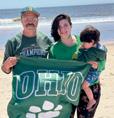
Aria enjoyed her first trip to the campus where her parents, Erica (Mack) Green, BSC ’14, and Arthur E. Green III, met as undergrads.
Bill Wyss, MA ’84, Rebecca Sethi-Wyss, AB ’15, and future Bobcat Rishi Sethi-Wyss enjoyed a blustery spring day at the Assateague Island National Seashore in Virginia. However, they are sad to report that no wild ponies would pose for this photo.
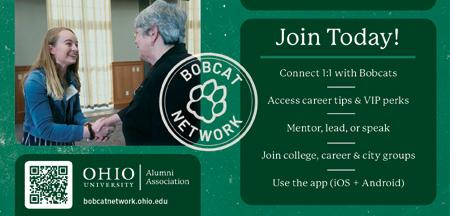
er and legal analyst for WKYC Studios’ 3News.
This year, Mary (Sray) Flenner, BA ’08, launched Tween Magazine, a quarterly print publication with empowering educational and lifestyle content for preteen girls. Goldman Sachs named 95 individuals to its Partner Class of 2024 last fall, including Alyson Shupe, BA, BBA ’08, who was selected based on commercial effectiveness, leadership and impact on firm culture.
This spring, Michaela (Hahn-Lawson) Burriss, BA ’09, was named policy director of the Ohio Justice and Policy Center, where she will support the organization’s goal of advocating for and providing free resources to individuals who are or have been incarcerated.
Mansour Gavin LPA elected Kathryn “Katie” Weber, BFA ’10, as a shareholder with the firm early this year. Weber also serves as assistant law director for Mayfield Village in Northeast Ohio and was recognized in the 2025 class of “Best Lawyers: Ones to Watch in America.”
The New York Times included “The Unmothers” by Leslie J. Anderson, MA ’11, on its Best 10 Horror Books of 2024 list. Reviewers praised the “chilling atmosphere” in Anderson’s novel, calling it “one you won’t want to miss.”
Scripps graduate Adam Wagner, BSJ ’12, was hired as editor and reporter for the new Capitol Bureau of WUNC’s North Carolina Newsroom initiative, where he coordinates state legislative coverage with WUNC and four other public radio partners.
Ohio Governor Mike DeWine appointed Keith Washburn, AAS ’12, BCJ ’14* , as Chillicothe Municipal Court Judge in February. He will serve the remaining term of retired Judge Tony Eddy through the November 2025 election cycle.
The Bronx Documentary Center hosted a screening of “Swift Justice” and Q&A with its creator, Victor J. Blue, MA ’13, last fall. Blue co-directed and produced the film, a rare look inside a Sharia courtroom in the heartland of the Talibancontrolled Afghanistan.
Spencer Plassman, BSC ’13, has joined Massachusetts-based wealth management firm Bulfinch Group as a financial representative.
Ruling Our eXperiences (ROX) named Lauren Hancock, MPA ’14, as its chief operating officer. As one of ROX’s two founding employees, Hancock helped drive the expansion of ROX’s research, education and programming for girls into 40-plus states.
In March, Everett Woodel, MBA ’14, was appointed as the Great Lakes Regional Administrator for the U.S. Small Business Administration, where he oversees day-to-day operations for Illinois, Indiana, Michigan, Minnesota, Wisconsin and Ohio.
Faith Voinovich, BSCHE ’19, was included in Venture Capital Journal’s 2025 Rising Stars list. She is a principal with the Ohio Innovation Fund, a role she ascended to in 2020 after joining the fund as an intern in 2018.
Adonis Durado, MFA ’20*, received a prestigious Philippines National Book Award for his fifth poetry collection, titled
“Ang Nakayatak kay Nayatakan (Who Steps Upon is Stepped Upon).”
The visual communication assistant professor in Scripps College of Communication won in the Best Book of Poetry in Binsaya (Cebuano) category.
In January, Sarah Parker, EDD ’22*, was inaugurated as the eighth president of Washington State College of Ohio. Previously, she was the college’s vice president of academic affairs and helped develop and expand its academic and workforce pathways.
After being drafted by both the San Francisco 49ers in the seventh round and 25th overall by the Canadian Football League’s Saskatchewan Roughriders this spring, former OHIO quarterback Kurtis Rourke, BSC ’23*, joined the NFL. The Ontario native is the first Bobcat to be drafted to the NFL since 2018 and the first Canadian quarterback to be drafted since 2001; he played for OHIO for five seasons before transferring to Indiana University last year.
Send your updates to ohiotoday@ ohio.edu or to OHIO Today Magazine , Ohio University, P.O. Box 869, Athens, OH 45701-0869.
The Ohio University Alumni Association’s annual Alumni Awards recognize noteworthy graduates. This year’s honorees are outstanding examples of generosity, resilience and professional success—proof that Bobcats are making an impact in Athens and beyond.
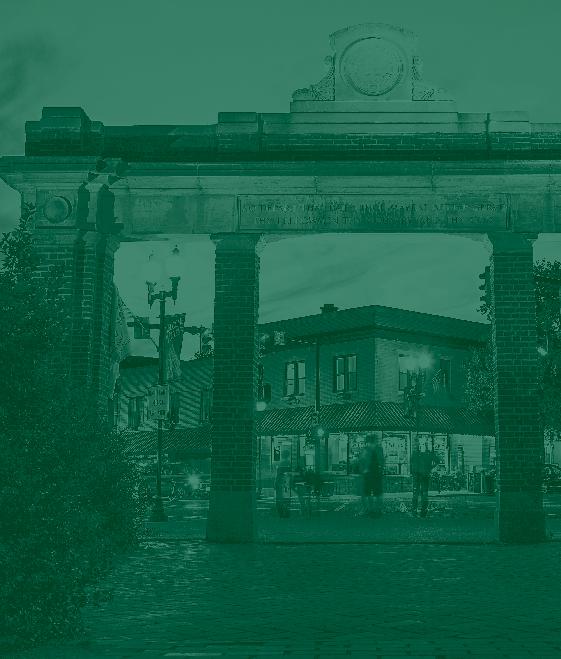
Alumnus of the Year
Jeffery Chaddock, BSC ’88, is the chief executive officer of Gahanna, Ohio-based Envisage Wealth, a private wealth advisory practice of American Financial Services, LLC. Over the years, Chaddock has continuously demonstrated his commitment to the success and well-being of Ohio University and Appalachian Ohio. His impact is evident in his extensive volunteer work, financial expertise on University boards and remarkable philanthropic contributions. Last year’s renaming of the Chaddock + Morrow College of Fine Arts reflects the historic $25 million gift from Chaddock and his husband, Mark Morrow. Chaddock’s unwavering generosity, leadership and advocacy embody the true spirit of a Bobcat, making him a most deserving recipient of this prestigious honor.
Medal of Merit
Milbert “Milt” Brown Jr., MA ’82
Suzanne Hargrove, BSC ’86
Dr. Martin Tyler, BS ’64
Jonathan Walsh, BSJ ’95
Distinguished Service Award
Ronald Calhoun, BBA ’72
Angela (Hazlett) Krile, BSJ ’97
Charles J. & Claire O. Ping
Recent Graduate Award
Margaret Gatonye, MSES, MA ’20

Honorary Alumni Award
Hugh and Nikki Sherman
The Kermit Blosser Ohio Athletics Hall of Fame
Carime (Reinhart) Richter, BS ’08
Rudy Rott, BSM ’19
Cody Walters, BSPE ’16
2004 and 2005 Volleyball Teams
Know someone who you think deserves an Alumni Award honor?
The deadline to nominate for the 2026 cohort is Dec. 31. Visit ohio. edu/nominate for more information.
Jeanette W. (Haas) Katz, BSED ’40
Elizabeth “Ann” (Hawkins) Donaldson, AB ’44
Rupert D. “Twink” Starr, BSCOM ’46
Ruth (Lawson) Walsh, BFA ’46
Paul H. Miller, BSJ ’47
Patricia (Connor) Study, AB ’48
Jean (Hales) Andersen, AB ’49
Pauline F. (McDaniel) Burson, BSED ’49
Joseph E. Doran, BSCOM ’49
Cecil E. “Gene” Goin, BSCOM ’49
Dorie (McDowell) Yonally, BSED ’49
Marlain R. (Wahlberg) Evans, AB ’50
Elinor “Susie” (Bode) Miles, BSED ’50
Thelma “Jean” (Brookins) Tippett, BSED ’50
Jane A. (Kubach) Warkentin, BSHEC ’51
Dominic T. Arcuri, BSED ’52
Robert H. “Bob” Dougherty, BSME ’52
Donald E. Mann, BSCE ’52
Elza Sapp, BSED ’52, MED ’55
Leo H. Everitt Jr., BSEE ’53
Janice R. (Cohen) Glass, AAS ’53
Don M. Harvey, BSAE ’53
John M. Lusa, BSJ ’53
Robert J. Satava, AB ’53
JoAnn (Vance) Shotwell, AA ’53, BSS ’56
Richard B. Walker, BSCOM ’53
Margaret “Marge” (Laux) Wardlaw, BSCOM ’53
Mildred “Millie” (Tobey) Ham, AB ’54
William E. Jakes, BSED ’54
John L. “Pete” Mihelick, BSCE ’54
Kathryn “Kathy” (Dengler) Mihelick, AB ’54
Donna L. (McCullough) Robertson, BSED ’54
Madelyn J. (McDermott) Romeo, BSED ’54
William P. Shultz, BSCOM ’54
Donald K. Carew, AB ’55, MA ’56
Paul L. Kroh, BSED ’55, MS ’56
Ila L. (Elliott) Leatherman, BSED ’55
Ruth A. (Diley) Bock, BSHEC ’56
W.R. “Dick” Christensen, BSCE ’56
Donald L. “Doc” Del Corso, BSCOM ’56
Darcy L. (Crispin) Fortner, AA ’56
Shirley J. (Woodman) Dewire, BSED ’57
Kaye (Lafollette) Edmonds, BFA ’57
William M. Fox, BSAE ’57
Cynthia C. “Kippy” (Young) Gilbert, BSED ’57
James M. Kraft, BSED ’57
Joyce (Burnett) Whitmer, BSED ’57
David R. Brod, BSED ’58
Roger A. Carter, BSCOM ’58
David W. Foote, BSED ’58
Robert W. “Bob” Forloine Jr., BSJ ’58
Patrick J. Foy, BSJ ’58
Robert N. Ludwig, BS ’58
Daniel P. Morrison, AB ’58
Joan F. (Washington) Nabors, BSHEC ’58
Carl H. Ohnmeiss, BSCOM ’58
R. Smith Schuneman, BFA ’58, MFA ’60
Don K. Seward, BSCOM ’58
Patricia R. (Andrews) Brown, BSCOM ’59
Dennis Haines, BSCOM ’59
Thomas P. Hatfield, AB ’59
Martha L. (Weller) Henshaw, BSHEC ’59
Richard W. Sears, BS ’59
Ralph A. Slater, BSED ’59
James A. Snide, BSME ’59
Charles W. Todd, BSED ’59
Calvin T. Colson, BS ’60, MS ’63
Allen F. Ebbers, BSJ ’60
Kathleen A. (O’Malley) Roosa, BSED ’60
Barbara A. (Deye) Wallace, BSED ’60
Stephen Aichele, BSCOM ’61
N. Suzanne (Hufford) Bryant, BFA ’61
Carlotta “Cary” Eisen, BS ’61
Lora J. (Buchanan) Goman, BSED ’61
Karen “Kay” (Williams) Johnson, BSED ’61
Paul D. Morrison, BSCOM ’61
Curtis Petersen, BFA ’61
Ralph R. Wolfe, AB ’61
Letitia J. (Scheid) Curless, BSED ’62
James E. Davis, BSME ’62
Mary E. “Mimi” Embree, BFA ’62
Jack R. Kiewit, BSCOM ‘62
Lary D. Luzader, BFA ’62
Judith J. (Doughty) McLain, BSED ’62
Nancy J. (Swenson) Musser, BSED ’62
Karen M. (Spriggs) Snaufer, MA ’62
Frederick S. “Rick” Stock, BFA ’62
David D. Avdul, AB ’63
Richard E. “Dick” Barber, MS ’63
Jeffrey N. Beres, BSME ’63
Sandra A. Glab-Lake, BSED ’63
Diane L. (Kollmorgen) Greer, BSED ’63
Nancy L. (Hamilton) Jarrells, BSED ’63
Richard D. Kahoe, MA ’63
Louis E. “Gene” Startzman, MA ’63, PHD ’70
Jennifer (Douthit) Boget, AB ’64
Charles L. “Chuck” Carpenter, BSED ’64
Linda (Miller) Hendrie, BSED ’64
Richard A. Lewis, BSME ’64
Patricia A. (Breyley) Pearce, BSED ’64
Robert L. Ramus, BS ’64
Paul A. Studly, BBA ’64
Barbara (Schaub) Thode, BSED ’64
Florence E. (Strawn) Tipple, BSED ’64
James F. Yerian, BS ’64
Frank M. Beardman, BBA ’65
Donald J. Britt, AB ’65
John R. Browne II, BA ’65
Roger C. Eckert, BSJ ’65
Connie S. (Belleville) Keller, BFA ’65
Gerald H. “Jerry” Knapp, BSCHE ’65
David B. Meister, BSED ’65
Matthew “Jim” Mogus, BSED ’65
Susan D. (Harris) Roby, BSED ’65
Science innovator and OHIO supporter passes

When Jeanette (Gescy) Grasselli Brown, BS ’50, HDS ’78, joined Ohio University’s chemistry program in the 1940s, she was often the only woman in the room. Her groundbreaking career and decades of transformative philanthropy show that being first often means lighting the path for others to follow.
Known to friends and family as Jenny, Grasselli Brown passed away on July 15, 2025, at age 96. She leaves behind a legacy of steadfast generosity, scientific insight and transformative leadership.
Grasselli Brown endowed numerous funds and scholarships, including the Jeanette G. Grasselli Brown Undergraduate Research Award; she also made significant contributions to the Cutler Scholars Program, the chemistry department, the Frontiers in Science Lecture Series and the Kennedy Museum of Art.
Her equally remarkable professional accomplishments include more than 90 publications, nine books and numerous accolades, including last fall’s Pittcon Heritage Award, which recognizes innovation that fosters scientific discovery.
Read more about Grasselli Brown’s remarkable life at ohio.edu/ grasselli-brown.
Sandra G. (Ehrlich) Teren, BSED ’65
Norman H. Baron, BSCE ’66
Judy A. (Rey) Brim, BSED ’66
John E. Hoover, MA ’66, PHD ’73
Albert G. Olhava, BSED ’66
Eugena E. (Walter) Schaefer, BS ’66
Thomas E. Vogel, BARCH ’66
Brian D. Weaver, AB ’66
Gerald W. Budzik, BSIT ’67
Chester L. Frear, BBA ’67
Paul L. Johnson, BSED ’67
Robert K. Lee, MA ’67
Jesse C. Livesay, BSED ’67
Alan K. Snode, BBA ’67
James M. Walter, BFA ’67
Susan (Arnold) Barton, MED ’68
Robin P. “Rob” Ewart, AB ’68
Darlene (Bayes) Melvin Moore, BSED ’68
Rebecca (Berry) Tomich, BSED ’68
James F. York, MS ’68, MS ’23
Robert “Bob” Bednarczuk, BSED ’69
Richard D. Irvin, AB ’69
Donald A. “Sonny” Riley, BSED ’69
Regina M. (Weilbacher) Rosier, BSED ’69
Michael K. Welsh, BSED ’69, MED ’75
James Damron, MED ’70
Thomas P. Frazier, BSJ ’70, MA ’72
Charles W. Hall, MA ’70
Sarah E. (Spradling) McGuire, BSED ’70, MED ’72
James W. “Oz” Osborn, BSED ’70
Mary C. Quinlan, BSED ’70
Ronald F. “Rosko” Roskovich, BS ’70
Frederick E. Burdell, MED ’71
Joel K. Greenberg, AB ’71
Sallie Hall, BSED ’71
Barbara (Bair) Kolp, BSED ’71
Ronald J. Lagoe, MA ’71, PHD ’76
Melinda R. “Mimi” Lockard, AB ’71
Thomas Schultz, MED ’71
John W. Carroll, BSEE ’72
Linda S. Christman, BSED ’72
John K. Garrett, BSED ’72
Norma L. (Ebbing) Krueger, BSED ’72, MED ’81
Benson M. Meyers, BGS ’72
Judy K. Powers, BSED ’72
Russell R. Ross, MAIA ’72
Dean E. Wegehaupt, MED ’72
Gary C. Wilson, BBA ’72
William A. Andersen, MBA ’73
James K. Andrews, BBA ’73
Patrick J. Crosbie, BSCHE ’73
Chris W. Dear, BSED ’73
Kathryn A. Drummer, BSED ’73
David J. Dvorchak, BGS ’73
Peter L. Goss, PHD ’73
Phyllis (Pichler) Harrison, BSHEC ’73
Timothy A. Malloy, BSC ’73
Margaret E. Ronning, BGS ’73
Nancy J. (Moss) Tullos, BSC ’73
Jeffrey A. Balazs, AB ’74
Gladys (Purchess) Batchelor, BGS ’74, MED ’78
Larry P. Koons, BFA ’74
Leonard R. Miller, BS ’74
Mark D. Miller, BBA ’74
Mark L. Miller, BS ’74
Orley R. “Skip” Peterson III, BSJ ’74
Mary A. (Miller) Wahl, BS ’74
Eric K. Christiansen, BS ’75
Garry J. Miller, AB ’75
Bruce A. Mitchell, BGS ’75
Sharon K. Yemich, BSJ ’75
Gilbert L. Bauer, BSJ ’76
Daniel L. Cook, BSED ’76
Barbara R. (Biel) DiJacklin, AB ’76
Barbara (Trela) Hajes, BGS ’76
David E. Kepple, BSJ ’76
Richard A. Luther, BBA ’76
Gary T. Pillar, BBA ’76
Scott H. Ballou, BSC ’77
Joan (Bushek) Schnabel, BFA ’77
Mark D. Swart, AB ’77, MLS ’86
Robert E. Dixon, BBA ’78, MBA ’79
Eugene H. Oesch, MA ’79
Theresa M. Engler, BBA ’80
Kabir D. Malumfashi, BSC ’81
Kyle N. Towers, BSME ’81
Scott E. Hart, BFA ’82
Matilda “Tillie” (Titus) Heavilin, MED ’82
Debora (Shenk) Niederriter, MS ’82
Keith E. Ramsey, AB ’82
Michael D. Conner, AB ’83
Denise L. Deime McGuire, BSED ’83
Sara “Sally” (Sherrick) Meltzer, BS ’83
John G. Shimko, BSED ’84, MED ’94
Linda C. Fridy, BSJ ’85
Thomas E. Lynch, BSC ’85
Penelope “Penny” Fox, AA ’86
Rebecca E. Blackstone, BSED ’87
Caroline B. Dean, MHSA ’87
Beverly J. (Papa) Hornsby, BSED ’87, MED ’91
Benton V. “Ben” Jessup, BBA ’87
Lynne M. Meehan, BFA ’87
Margaret Riley, MAIA ’87, PHD ’91
Mary J. (Bryant) Jenkins, BSED ’88
Hector Flores, BGS ’89
John F. Gardner, AAS ’89, BSN ’03
Ned L. Underwood Jr., MSS ’89
Laura A. Serna-Maytorena, AB ’91, BSED ’09
Vernon “Phil” Brumbaugh, MBA ’94
James “Jamie” Laughlin Jr., MS ’94
Timothy W. Covell, MA ’95
Laura E. “Betsy” Luther, BGS ’95
Cheryl A. (Rambacher) Davis, BSRS ’96
Mary C. Brady, BSN ’97
Jeremy J. Dollings, AB ’97
Thomas D. Foster, BSS ’01
Jason D. Culver, BBA ’04
Courtney E. (Clark) Roush, BSED ’05
Ranita L. “Mamee” Mullens, AAS ’06
Jesse D. Hathaway, BA ’10
Mathew D. Galli, BBA ’11
Bridget N. Mallon, BSJ ’13
Christine M. (Peddicord) McGeorge, BSN ’13
Jamie D. White, AS ’14, BA ’15
Molly I. (Aldridge) Carroll, BSED ’15
Joseph M. Burkhart, BBA ’20
Margaret L. “Peggy” Adelsberger, Athens, Ohio; retired custodial worker, Mar. 5
C. Robert Antle, Athens, Ohio; retired director of building maintenance, Apr. 2
Joyce C. Atwood, BSED ’65, MED ’69, Chillicothe, Ohio; former director of development, Chillicothe campus, Apr. 10
James R. “Rick” Barnes, Chillicothe, Ohio; retired instructor and IRIS Center director, Chillicothe campus, Feb. 20
Charles E. Brient, Athens, Ohio; associate professor emeritus of physics, Dec. 15
Clair E. (Topolosky) Carpenter, BFA ’92, New Castle, Ohio; retired assistant director of administration and information, Kennedy Museum of Art, Mar. 18
Virginia C. Douglas, Athens, Ohio; retired custodial worker, Jan. 3
Max W. Evans, BSED ’51, Athens, Ohio; professor emeritus and former chair of the School of Applied Behavioral Science and Educational Leadership, Nov. 26
C. Howard Fokes, BSHEC ’86, Athens, Ohio; former project manager, facilities, Feb. 22
Judy A. (Franks) Gorman, BS ’69, MS ’76, Athens, Ohio; medical technologist, Apr. 1
Emily E. (Bradfford) Gulker, Portsmouth, Ohio; retired instructor, Southern campus, Apr. 30
Pamela F. (Vander Ark) Harvey, Athens, Ohio; accounting support senior specialist, Dec. 13
Jack E. Humbles, Greenfield, Indiana; retired ESOL instructor, Feb. 3
Dewey F. King, Shade, Ohio; retired electronics specialist, Dec. 2
Mark E. Loudin, Athens, Ohio; retired multimedia producer/ director, Mar. 12
Evelyn L. McKnight, Athens, Ohio; former secretary, Feb. 18
Irena (Diamentis) Mickunas, BBA ’72, Athens, Ohio; former fiscal management specialist, Mar. 4
Cathy M. Morris, Jacksonville, Ohio; retired custodial worker, Dec. 14
John R. Olson, Saint Paul, Minnesota; former sports administration instructor, Jan. 24
Lorna I. Peterson, Buffalo, New York; former library employee, Nov. 11
Mary Lee (Kerr) Powell, BS ’62, The Plains, Ohio; retired medical technologist, Dec. 26
Myra K. “Kathy” Rose-Grippa, Athens, Ohio; professor emerita of nursing, Mar. 10
Dow F. Sanders, Glouster, Ohio; retired custodial worker, Feb. 27
Rebecca L. Schirtzinger, Guysville, Ohio; retired clerical specialist, Feb. 17
Beverly I. (Cochran) Schumacher, Athens, Ohio; retired cook, Mar. 10
Don H. Shamblin, Richfield, Ohio; associate professor emeritus of sociology, Jan. 1s5
David H. Smith, Carroll, Ohio; former environmental health specialist, Nov. 18
Carey J. Snyder, Athens, Ohio; assistant professor of English literature, Mar. 20
Margaret C. Thomas, MA ’81, Athens, Ohio; lecturer emerita of electrical engineering and computer science, Jan. 25
Robbyn J. Turner, AB ’86, MA ’87, Dayton, Ohio; former coordinator for career programs, Jan. 12
Maureen M. Weissenrieder, Athens, Ohio; professor emerita of Spanish and retired associate dean of the College of Arts and Sciences, Dec. 22
Dennis S. Whitlatch, Athens, Ohio; retired mail systems specialist, Nov. 23
—Includes individuals who passed away between Nov. 1, 2024, and Apr. 30, 2025. Information provided by the University’s Office of Advancement Services and staff research.
Send your updates to ohiotoday@ohio.edu or to OHIO Today Magazine , Ohio University, P.O. Box 869, Athens, OH 45701-0869.
MISSION STATEMENT
OHIO Today Magazine informs, celebrates and engages alumni, faculty, staff, students and friends of Ohio University.
Editor in Chief
Emma Frankart Henterly, BSJ ’10
Art Director
Sarah McDowell, BFA ’02
Contributors Advancement Services Operations Team
Diego Alvarado-Serrano
Laura M. André
Eli Burris, BSJ ’16
Taylor Burris, BSED ’17, MED ’18
Hannah Clark, MA ’24
Sabrina Curran
Scott Eklund / Red Box Pictures
Rich-Joseph Facun, BSVC ’01
Dustin Franz
Maria Gian, BSC ’23
Scotty Hall
Brian Jackson
Samantha Pelham Kunz, BA, BSJ ’17, MAA ’21
Anita Martin, BSJ ’06
Duane McDiarmid
John Nowak / TNT Sports Office of the University Registrar
Ohio University Mahn Center for Archives & Special Collections
Ohio University Press
Mary Reed, BSJ ’90, MA ’93
Ben Wirtz Siegel, BSVC ’02
Christofer Smith, BSC ’09, MED ’19
Emma Snyder-Lovera, BS ’26
Dylan Townsend, BSVC ’24
Brandon Vallance / TNT Sports
Julia Weber, BS ’25, MAA ’26
Mark Witton
Ohio University President
Lori Stewart Gonzalez
Vice President of Advancement and President/CEO of The Ohio University Foundation
Gregory Simmons
OUAA Executive Director
Jennifer Shutt Bowie, BSJ ’94, MS ’99
Vice President for University Communications and Marketing
Robin Oliver
Director of Content Strategy and Publications
Sarah Filipiak, BSJ ’01, BS ’23
The Watkins Printing Co.
Errata for the Spring 2025 issue follow. OHIO Today Magazine regrets the errors. The name of Jon M. “Jack” McMahon, BFA ’58, was misspelled in In Memoriam. The name spelling and degree for Matthew “Cenky” Lawson, BSSPS ’07, MSA ’14, were incorrect in Bobcat Sightings.
OHIO Today Magazine is published two times a year. Its digital companion is ohio.edu/ magazine. Both are produced by University Advancement, with funding from The Ohio University Foundation. Views expressed in them do not necessarily reflect the opinions of the staff or University policies.
Editorial office address: OHIO Today Magazine, Ohio University, P.O. Box 869, Athens, OH 45701-0869. Send questions, comments, ideas and submissions to the above address, via email to ohiotoday@ ohio.edu, or by calling 740-566-0344. Make address changes at ohio.edu/alumni or by mail via Ohio University, Advancement Services, P.O. Box 869, Athens, OH 45701-0869. Send details for the “In Memoriam” section to the latter or advinfo@ohio.edu.
Copyright © 2025 by Ohio University. Ohio University is an equal access, equal opportunity, and affirmative action institution.
@OHIOAlumni
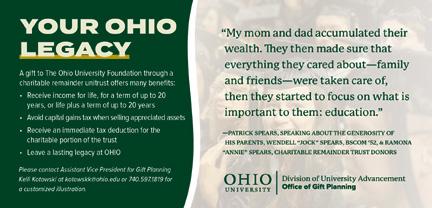
Josh Antonuccio, BSC ’96, MED ’17, is an associate professor, director of the School of Media Arts & Studies and a polymath of the music industry. In addition to serving as director of the Ohio University Music Industry Summit and faculty advisor of student organizations Brick City Records and Women in the Music Industry, he produces and hosts The Sycamore Sessions at the Nelsonville Music Festival and is an independent recording artist and music producer. He also is a Grammy-voting member of the Recording Academy and a board member of Stuart’s Opera House.

Visit ohio.edu/ magazine for the full Q&A with Antonuccio.
PHOTO BY BEN WIRTZ SIEGEL, BSVC ’02
What do you like to do in your downtime, other than making music? I love hiking and exploring National Parks; that’s a big thing for me.
Do you have a favorite? I’m going to say Zion, because we got into the lottery to hike Angel’s Landing, which is one of the craziest hikes in the United States. The last half-mile is a sheer drop-off on either side, thousands of feet down, and you’re literally holding onto a chain and just walking up a narrow boulder path to the top. The view from the top is breathtaking, extraordinary.
You have a big interest in artificial intelligence. What role do you think AI has in the music industry? I’ve heard this stated in different forms and I think it’s mostly true: Pure AI won’t take away people’s jobs; those who know how to use AI will get hired over those who don’t. And that reality is translating down to the creative industries. It’s not for me to say whether it’s right or wrong to integrate AI into your creative process. But the fact is that AI is transforming the way we work, so I think it’s vital for students to learn this technology as they navigate their careers.
What do you enjoy most about working with students? I love the collaborative process of teaching. I like being the facilitator to empower students to find their passion, their voice. It’s great watching them take off, both here and certainly beyond. —Emma Snyder-Lovera, BS ’26
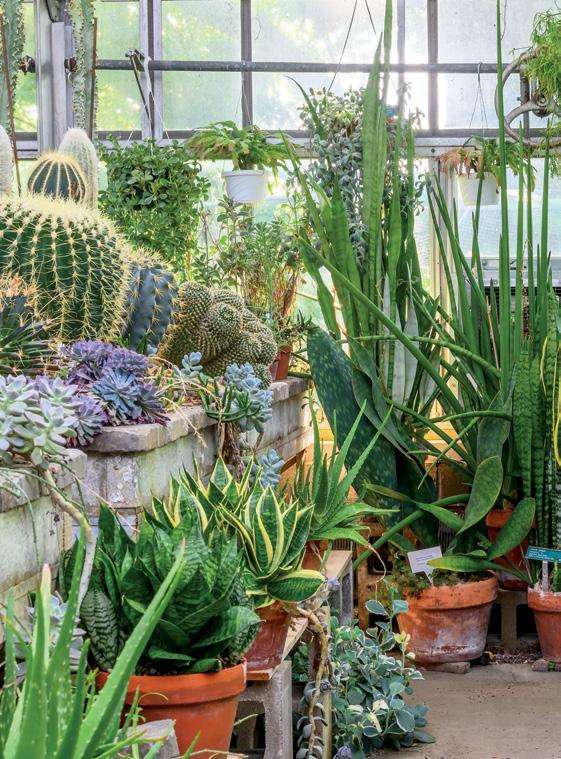
Built in 1972, the Environmental & Plant Biology Greenhouse on South Green features more than 4,500 square feet of orchids, cacti, carnivorous plants, ferns and more, including economically important species. The plant collection—which includes an adjacent, 1-acre garden—serves the research and educational interests of the environmental and plant biology program and other academic units. The garden is open year-round; visitors can arrange small group tours of the greenhouse by emailing manager Harold Blazier at blazier@ohio.edu.
“When students move out, the deer move in.” This was the caption on an OHIO Instagram post that received thousands of “likes” in early May, shortly after Commencement weekend. Followers joined in the fun, noting that the deer “got [their] summer resort back” and “we are fawning over our newest unDEERgrads.” Other campus critters weren’t left out; one person asked those still on campus to “tell the Treudley groundhogs we said hi!”
